Content marketing involves creating and distributing assets like videos, blog posts, and photos to reach your target audience and build relationships with them. And it has many moving parts.
But you can simplify the process by following our list of content marketing best practices.
Here are 15 activities to consider using in your content marketing plan.
1. Analyze Your Audience
Audience analysis helps you uncover data like psychographics (pain points, challenges, and desires) and demographics (age, gender, and salary) to inform which topics you cover and which types of content to create.
Use Semrush’s One2Target to start audience research.
Open the tool and enter up to five competitor domains. Click “Analyze.”
A report will load audience information. Click along the different tabs to view insights for demographics, socioeconomics, behavior, and audience overlap (where you can see other websites the audience visits).
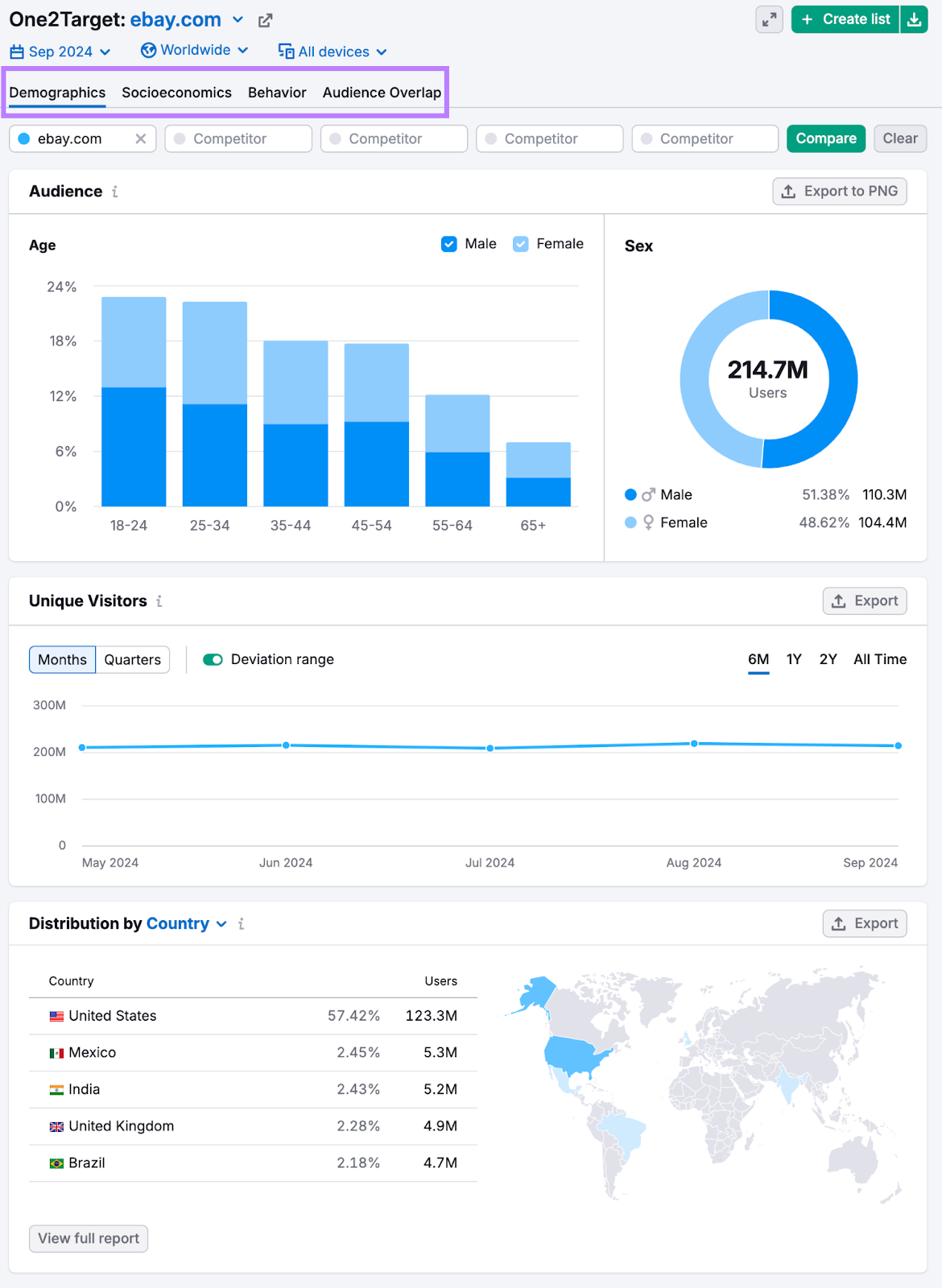
For example, if you click the “Behavior” tab, you can see which social platforms your audience spends time on. This lets you know which social platforms to create content for.
In the example below, you can see that this audience spends the most time on YouTube. Meaning it might be a good idea to create videos for this audience.
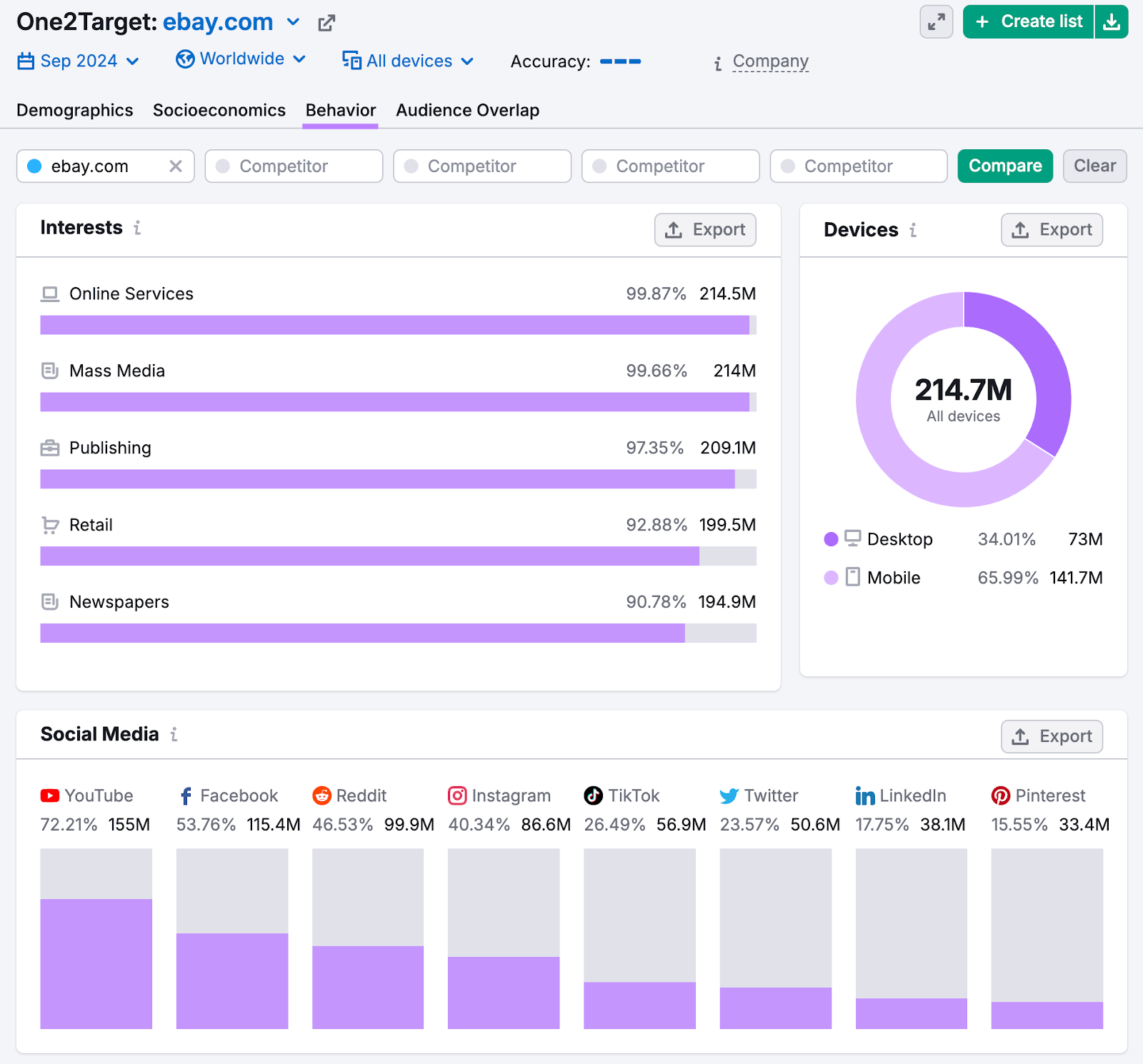
Then, head to the Audience Intelligence app for even more audience insights.
Once in the app, name your report and add an X (formerly Twitter) handle for a competitor to analyze their followers. And click “Create new report.”

You’ll then be able to see an overview of the audience. Which includes demographic information, their favorite brands, etc.
Click “See all sources” in the “Top content sources” widget.
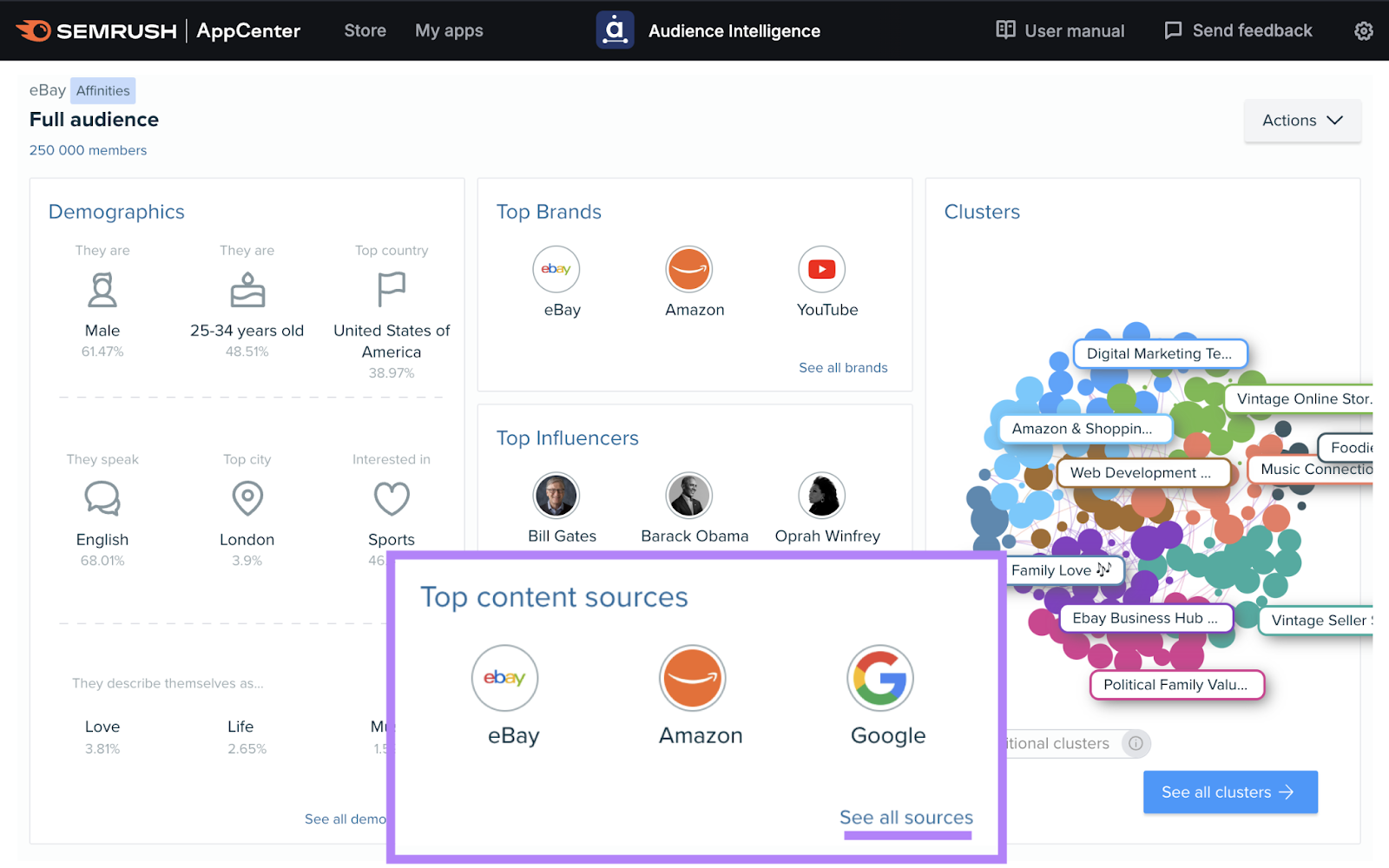
This report reveals the content your audience posts. Like the hashtags they use and the websites they frequently share.
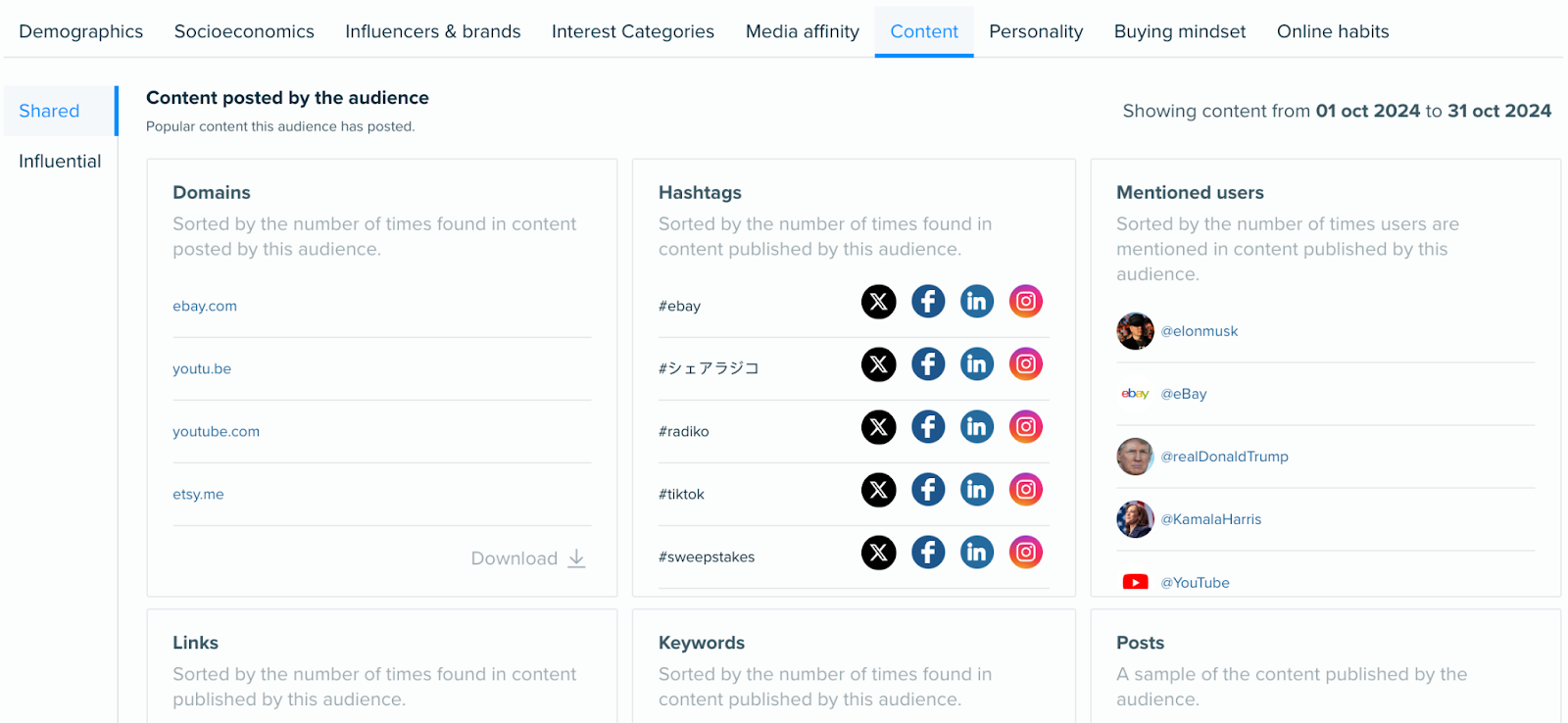
Use this information to ideate topics for your own content that your audience is likely to be interested in.
2. Review Your Competitors
Analyzing your competitors’ content strategies helps you spot what may be working for them, which can inspire your own strategy.
You can review your competitors’ social media content by heading to their social profiles and examining each post.
Look for engagement such as likes, comments, and shares. And make a note of the topics and content formats (such as videos, carousel posts, etc.) that receive the most interaction.
Then, use Semrush’s Keyword Gap tool to see which keywords your competitors rank for but you don’t.
Open the tool and enter your domain and those of up to four competitors. Adjust the country if needed and click “Compare.”
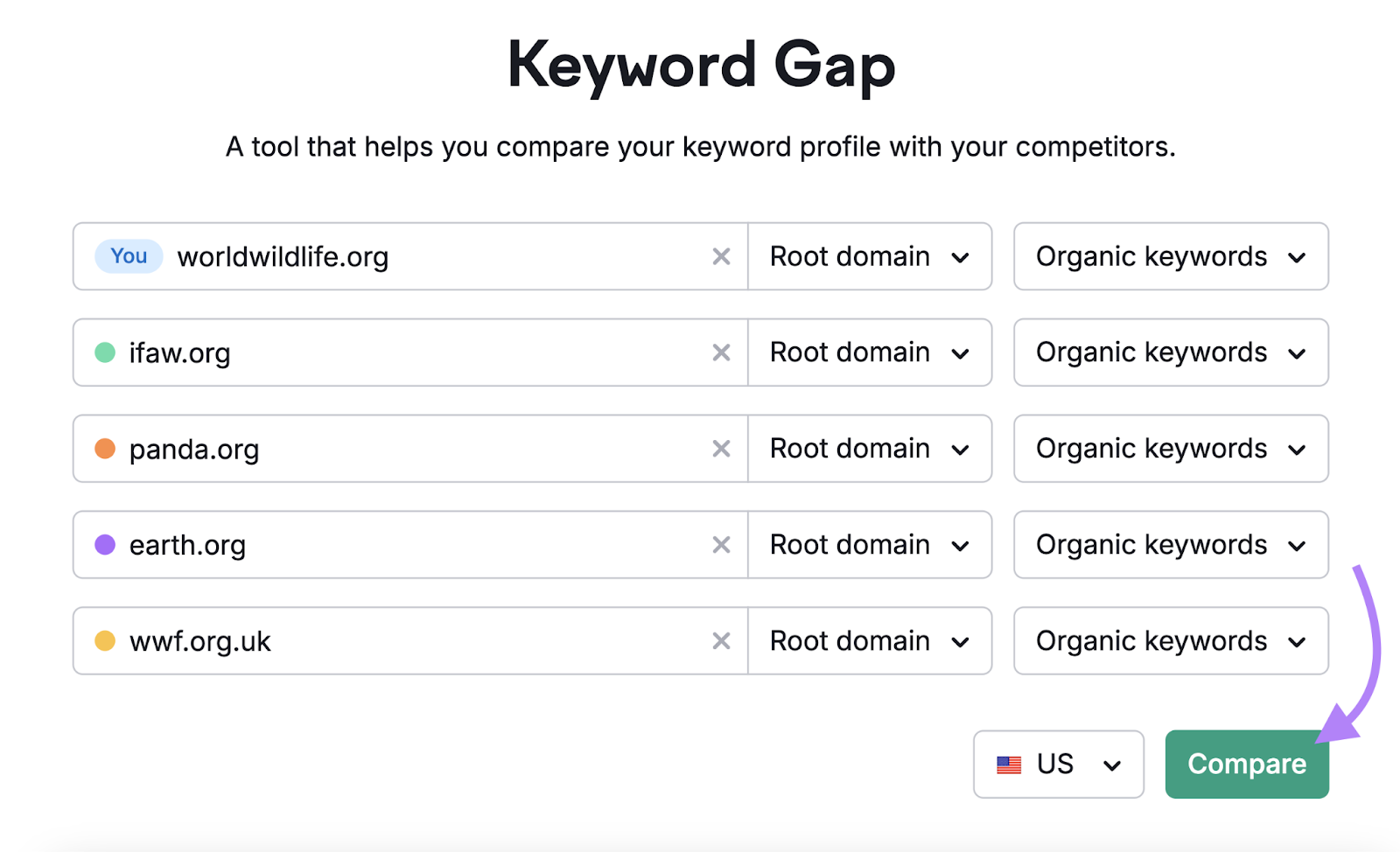
Scroll to the keyword table and click “Untapped.” This shows you all the keywords you don’t rank for but at least one of your competitors does.
Also, click “Missing” to view the keywords you don’t rank for but all your competitors do.
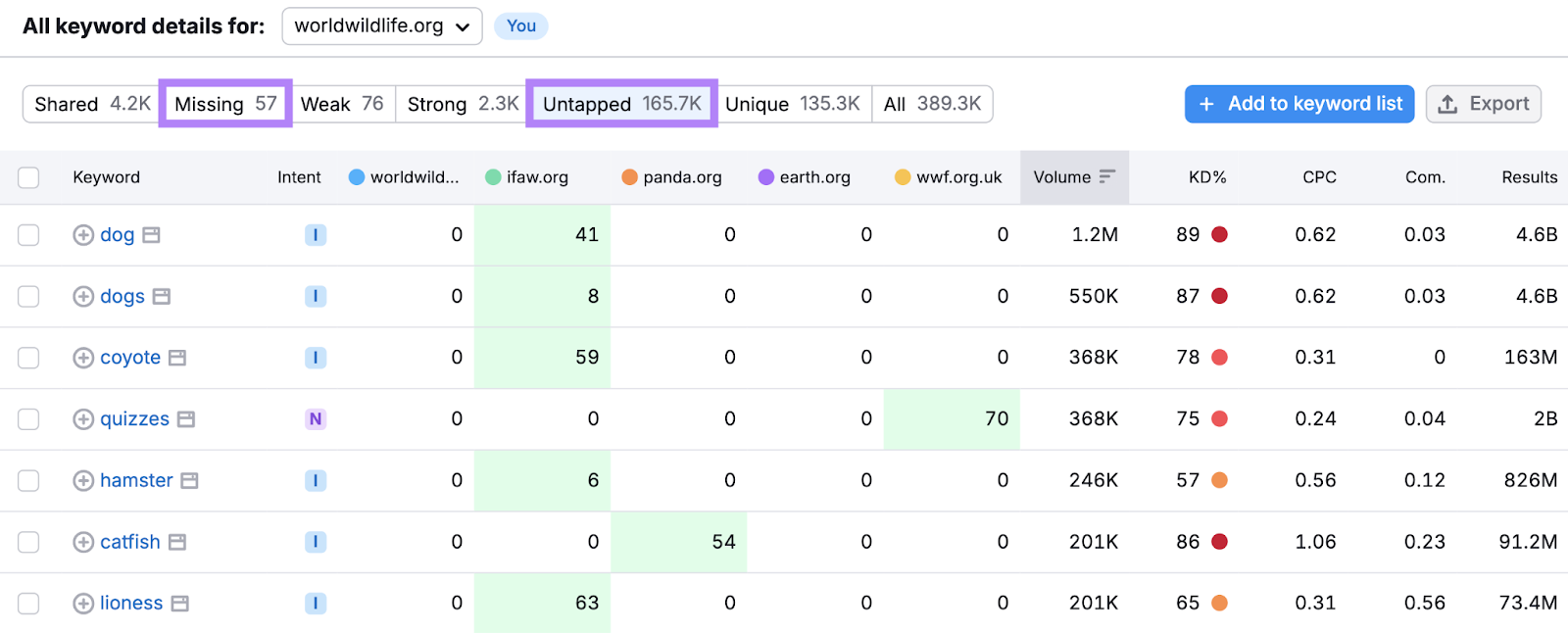
You might want to write blog posts about or create other pages for these keywords. To compete with your rivals in search results.
3. Define Your Messaging
Your messaging is how you communicate what your audience should know about your company and encompasses elements like your brand voice, core values, and what sets you apart from your competitors.
And defining your messaging sets the foundation for how you’ll communicate with your audience across all platforms and pieces of content.
For example, this Nike page lists making sport accessible as one of their core values.

And they’ve built that value into their messaging that they use across their content strategy. Like in this Instagram post that highlights players from the Paris Paralympics.
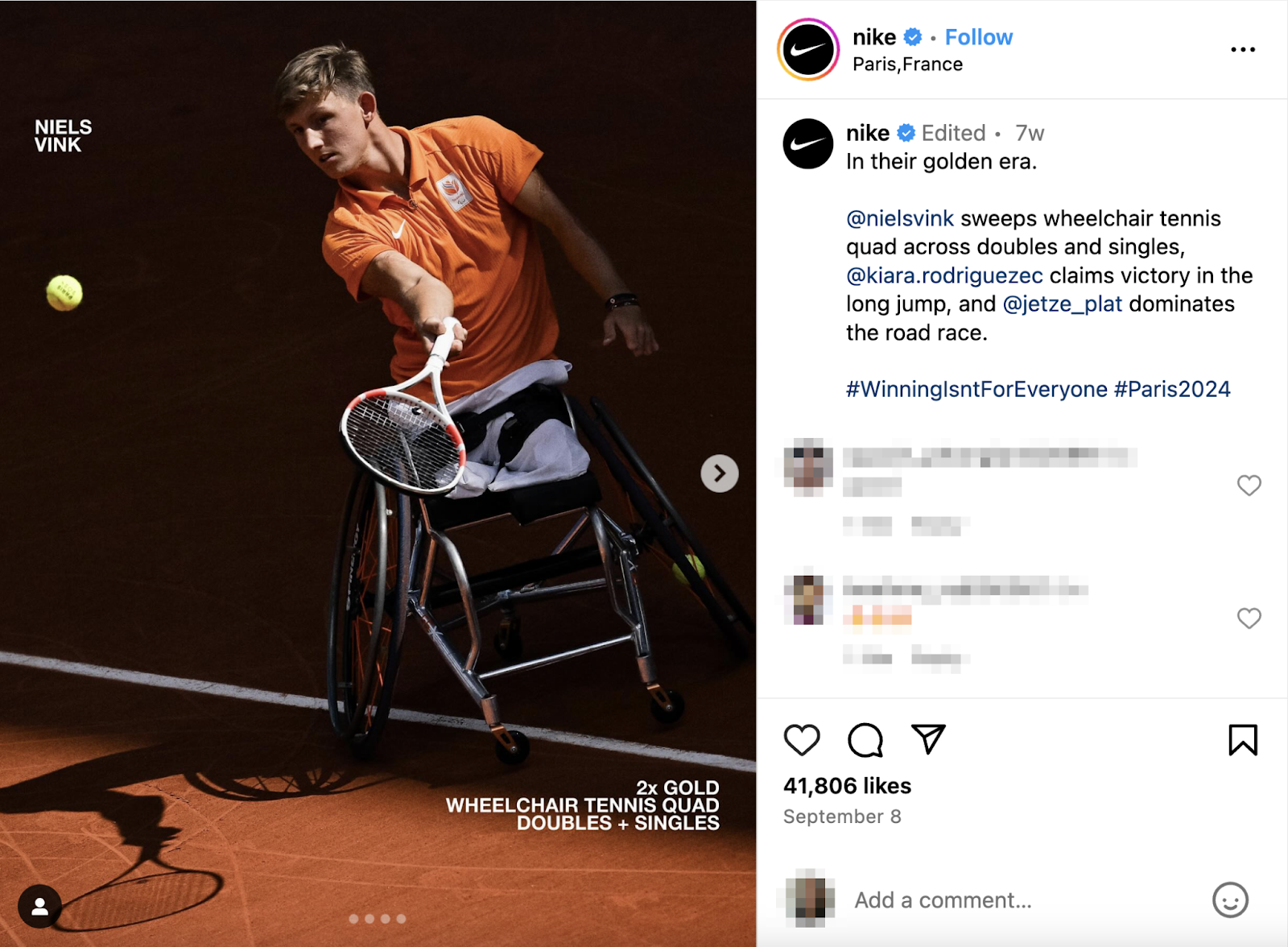
Or this free PDF that helps hijab-wearing athletes and teammates create a respectable and fun environment for everyone.
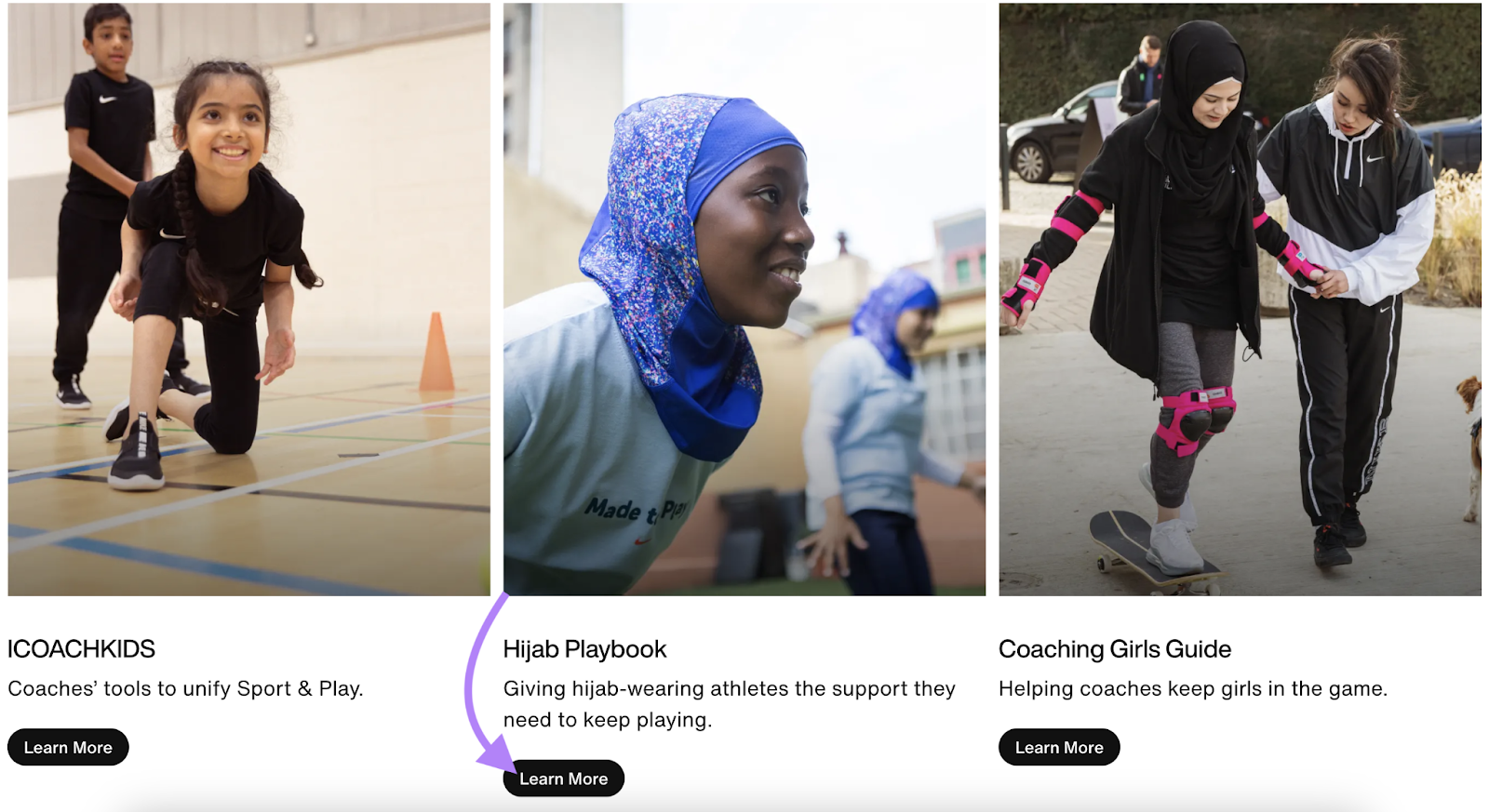
So, refine your messaging to make it easier to come up with—and execute—content ideas.
Here are a few tips to define your messaging:
- Identify the core values that reflect your brand and resonate with your audience
- Understand your audience's needs, desires, and pain points (this should be easy if you’ve already analyzed your audience)
- Write a value proposition (a statement that describes the benefit of buying your products or services) that sets you apart from competitors
- Establish a distinct and consistent voice
4. Set Goals and KPIs
Setting goals provides a roadmap for your content marketing efforts and guides you in choosing key performance indicators (KPIs) that will help you track progress toward those goals.
KPIs are specific metrics that indicate whether you’re on track to meet your objectives.
For example, if your goal is related to increasing brand awareness, a relevant KPI would be daily sessions for your website. And you can review your website analytics regularly to see if you’re reaching a number that aligns with your specific goal.
Here are some tips for defining goals and KPIs:
- Set goals that are aligned with your company’s broader objectives
- Take your budget into consideration to help you set realistic goals
- Research industry benchmarks if you’re unsure what numbers to aim for
Further reading: 14 Content Marketing Metrics to Track for Success
5. Build a Dedicated Content Team
A dedicated content team that splits up tasks among experts in different areas helps you grow and scale your strategy faster.
The roles you add to your content team depend on your goals and overall content strategy.
But most content marketing teams have one to three specialists/roles, according to our State of Content Marketing report.
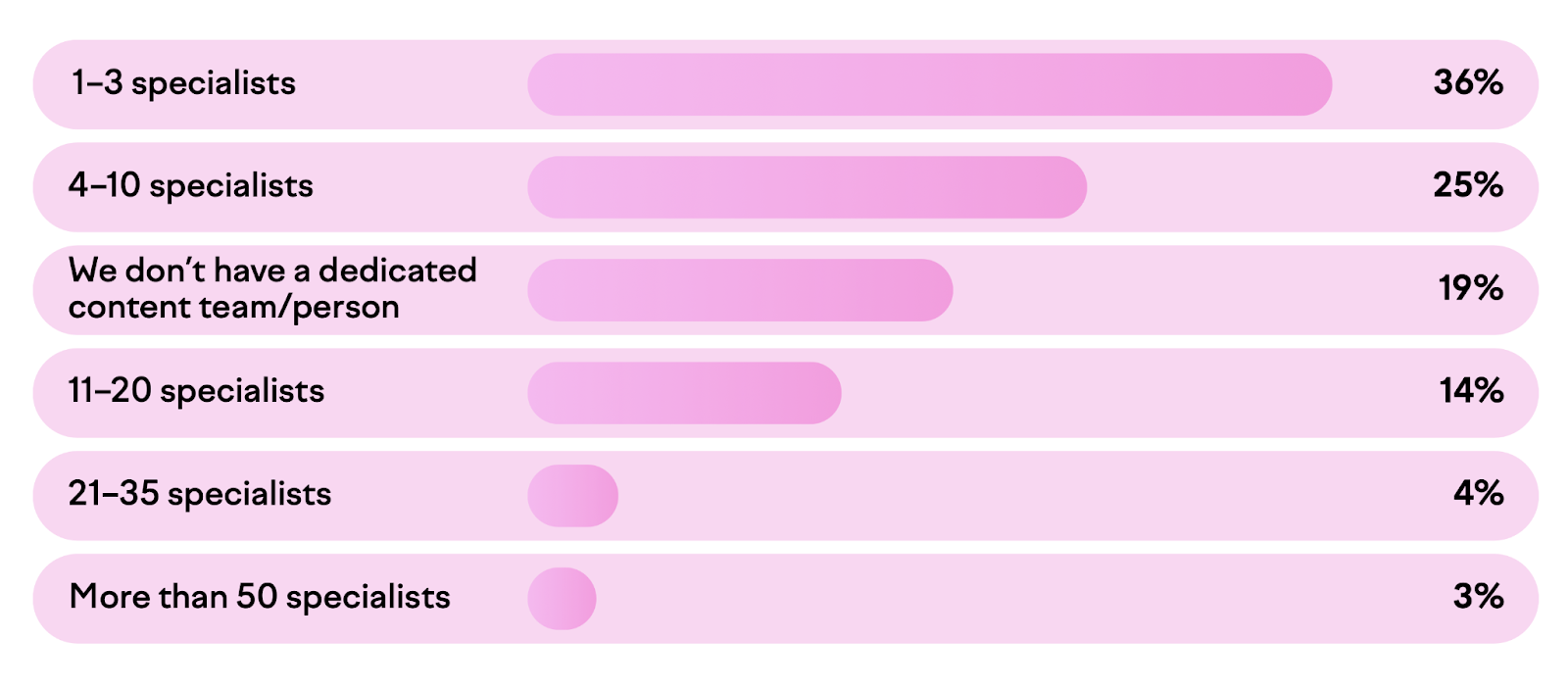
Our research also found that the most common in-house specialists were marketing managers, writers/content creators, and social media managers.
Other common roles for content marketing teams include:
- Content marketing manager
- Content marketing strategist
- SEO specialist
- Head of content marketing
- Designer
- Web developer
- Email marketing specialist
- Data scientist
These roles can remain in-house. Or, you can outsource to agencies and freelancers to fill any gaps.
Outsourcing marketing activities related to content can save time, money, and let you tap into expertise that in-house employees may lack.
Ask yourself these questions if you’re unsure whether you should outsource or hire in-house for certain roles:
- Do we have the budget for an in-house role?
- Do we have the internal expertise and bandwidth to manage this role in-house?
- Do we need a high level of direct control over this role's day-to-day tasks?
- Does this role rely on proprietary information or internal processes that could be difficult for external hires to access?
- Will this person have a consistent workload?
6. Incorporate User-Generated Content
User-generated content (UGC) is any content created by your customers or other contributors, and it adds to your content efforts without requiring additional work.
Here’s an example of UGC on Instagram (you can tell this is likely UGC because Apple credited the photo to someone else):

Some examples of UGC include:
- Testimonials (written or video)
- Blog articles that mention your product or service
- Videos and photos that showcase your product or service (like unboxingings or video tutorials)
- Podcast episodes talking about your product or service
You can collect UGC with a tool like Brand Monitoring.
After configuring the tool, you’ll get notified anytime someone uses your brand name or branded terms across the web.
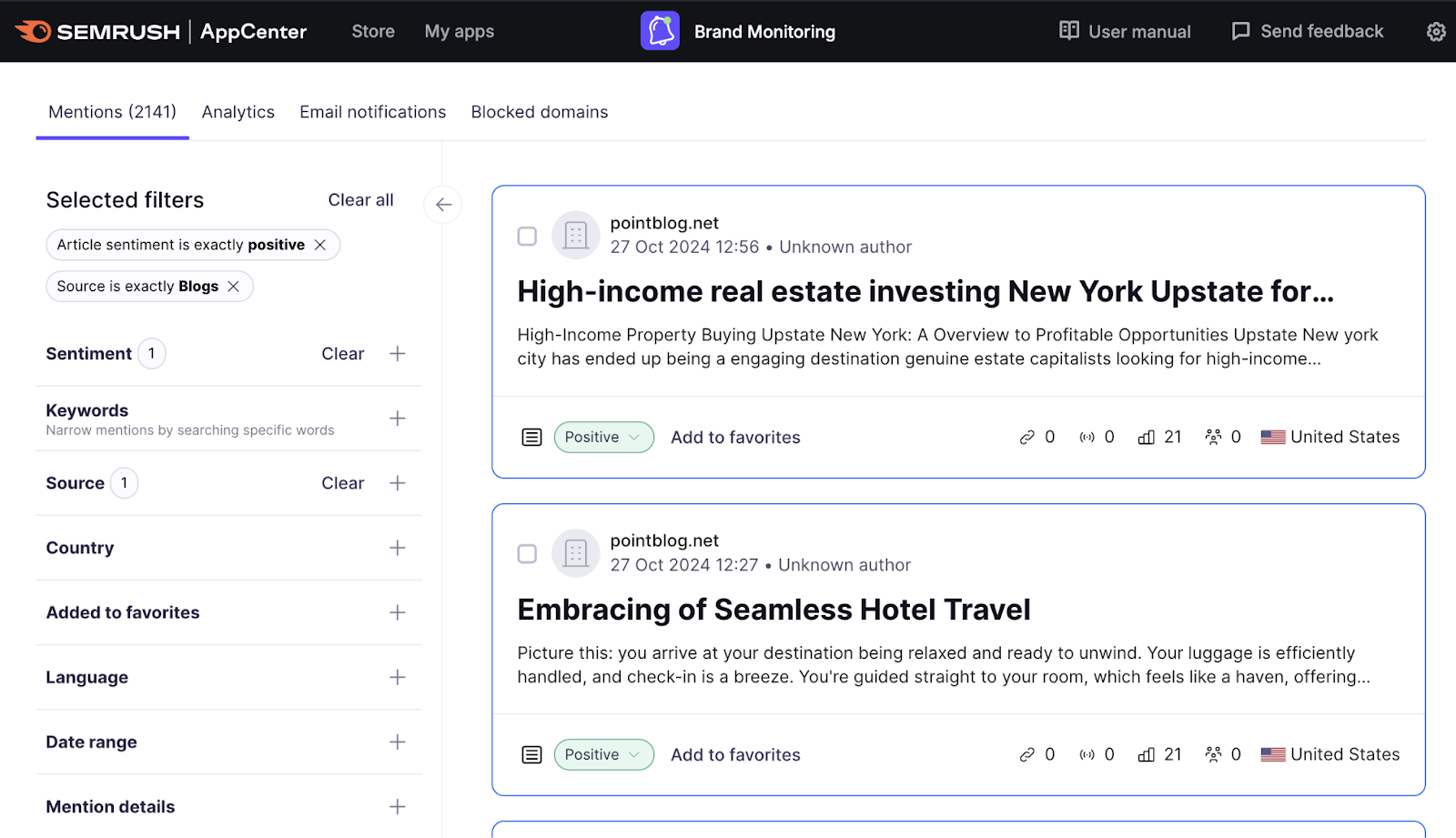
Look for blog posts/articles that mention your brand or products. And ask if you have permission to reuse their content for your own marketing purposes.
7. Perform Keyword Research
Keyword research is a process that involves finding queries relevant to your brand that your target audience types into search engines, and creating content around those terms can help you rank, gain traffic, and even convert users.
Find keywords using the Keyword Magic Tool.
Start by entering a broad keyword related to your business. Then, enter your domain (for personalized recommendations), adjust the country (optional), and click “Search.”
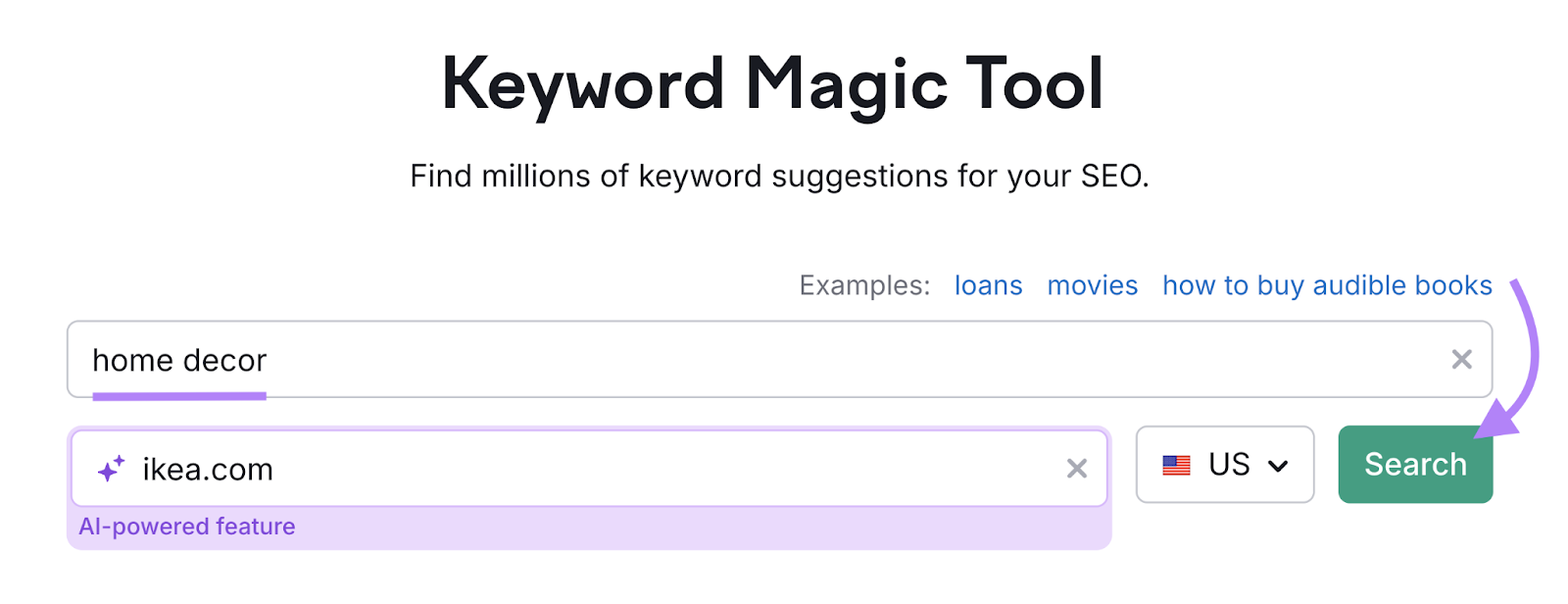
The tool will pull up a list of relevant keywords. There will be numbers beside individual keywords noting your position in the search engine results pages (SERPs) if your site is already ranking for that keyword.
You’ll also get data like each keyword's Personal Keyword Difficulty (PKD %) score—how difficult it is for your specific site to rank in the top 10 results for each keyword.
So, look for keywords with lower Personal Keyword Difficulty percentages. As those are likely easier to rank for.
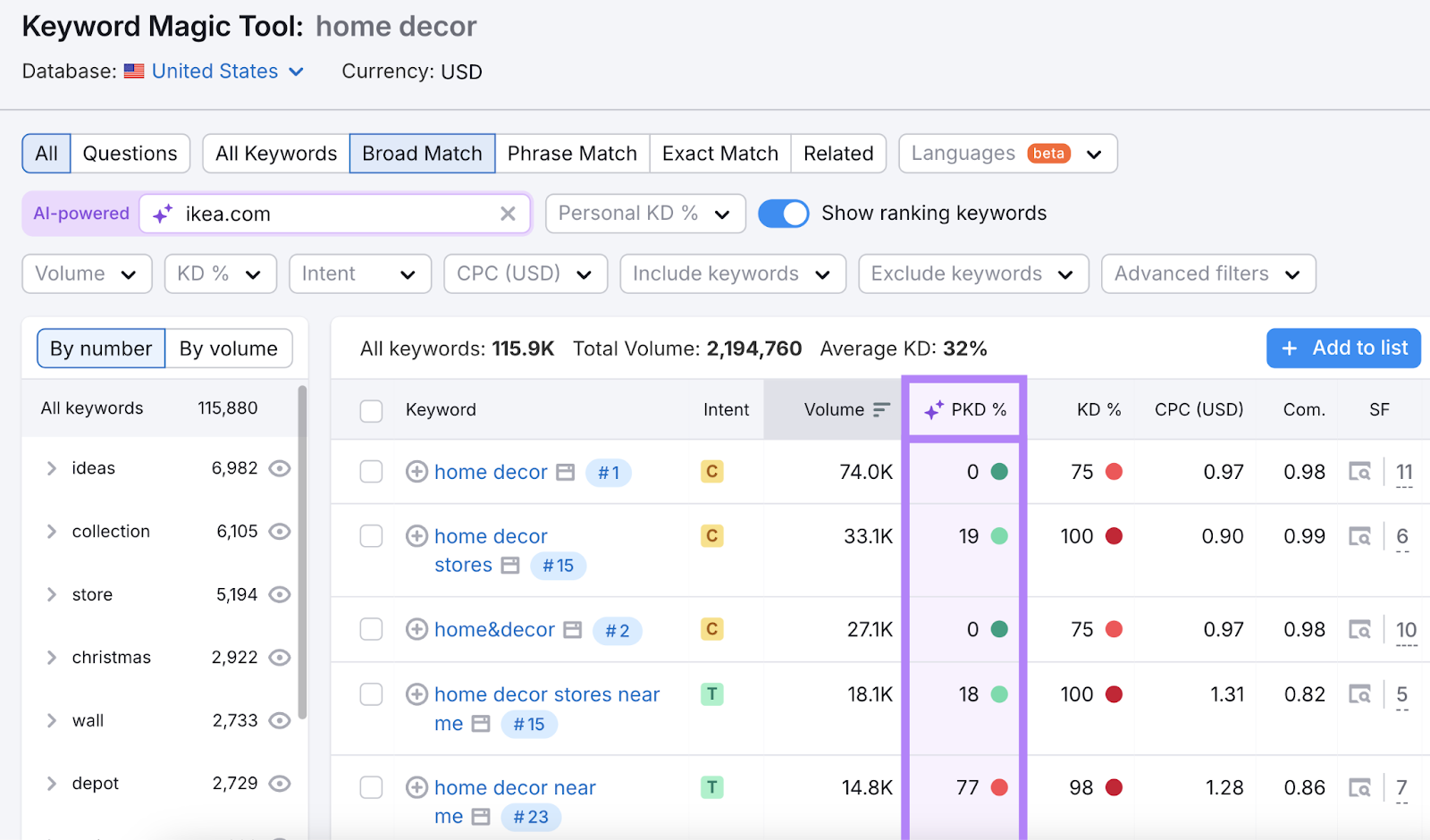
You should also pay attention to the keyword’s volume (its number of monthly searches). And its search intent—the reason someone searches that query.
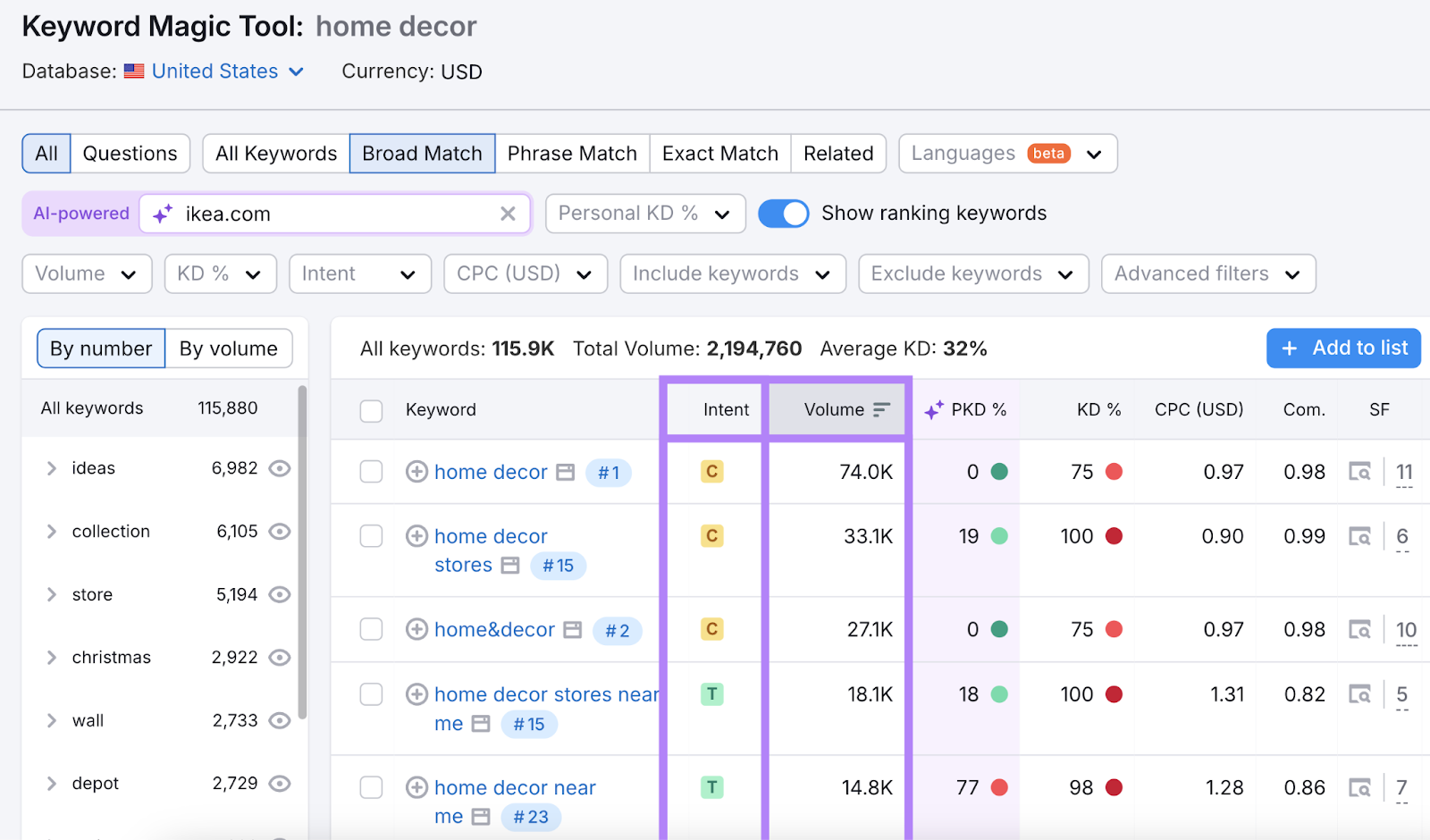
When you find a keyword you’d like to use, hover over the “+”sign and click the hamburger menu. This opens a widget where you can add keywords to lists.
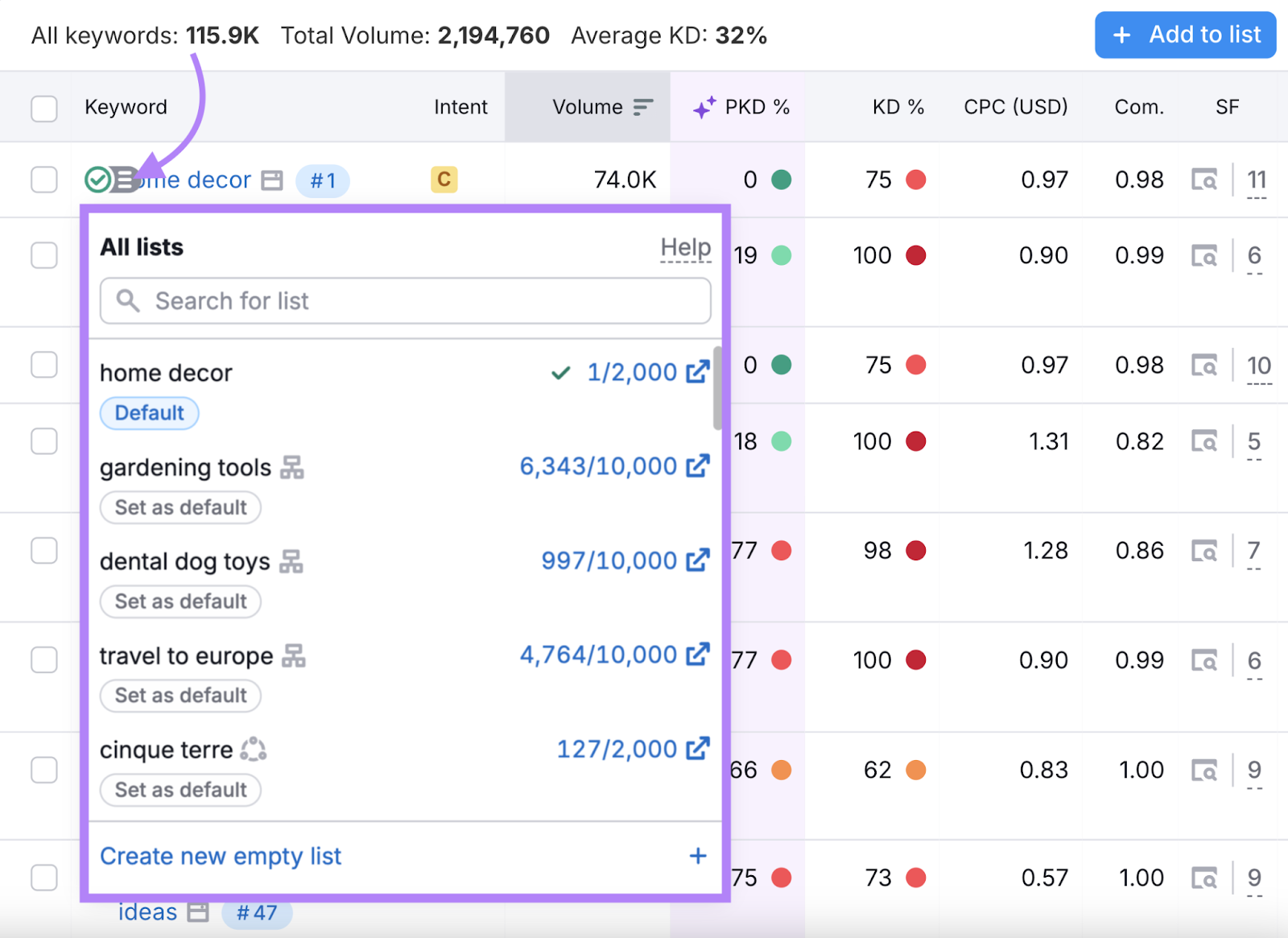
Creating lists helps you and your team organize keywords for later reference.
For example, you can create a list of potential keywords for your SEO specialist to review.
8. Strengthen Your Site’s On-Page SEO
On-page SEO refers to the activities you perform on webpages to help them rank higher in SERPs.
It includes techniques like:
- Using keywords in URLs
- Writing keyword-rich title tags (HTML that specifies your webpage titles)
- Adding internal links (links to other pages on your site) and external links (links to other sites) in content
- Writing unique and informative content
Use the On Page SEO Checker to get a detailed analysis of your site’s on-page SEO, so you know what to improve.
After configuring the tool, go to the “Optimization Ideas” tab and click the blue “# ideas” button beside a page you want to optimize for more details.
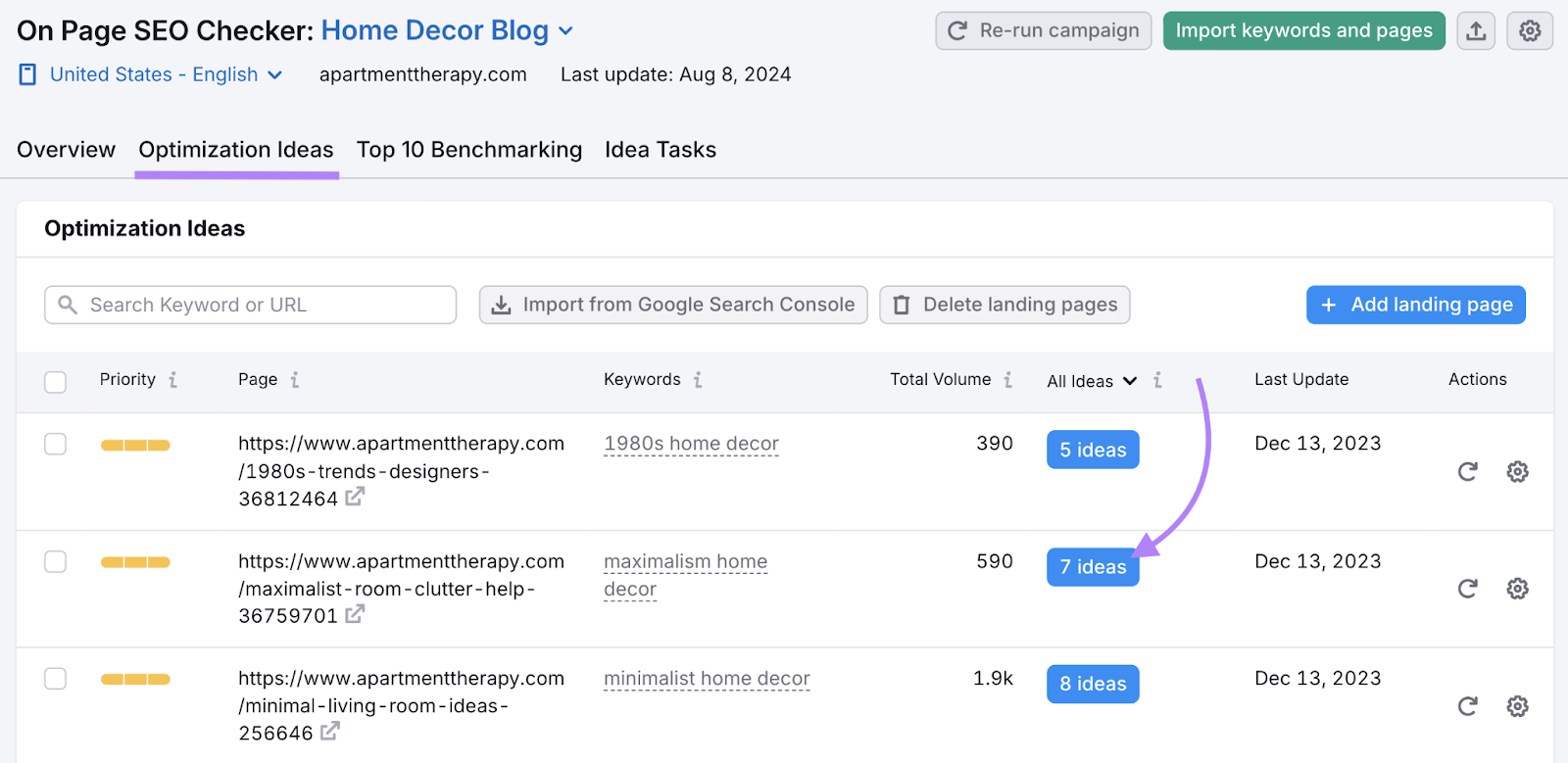
You’ll get a report with suggested fixes. Such as improving your SEO strategy by targeting the right keywords for the page.
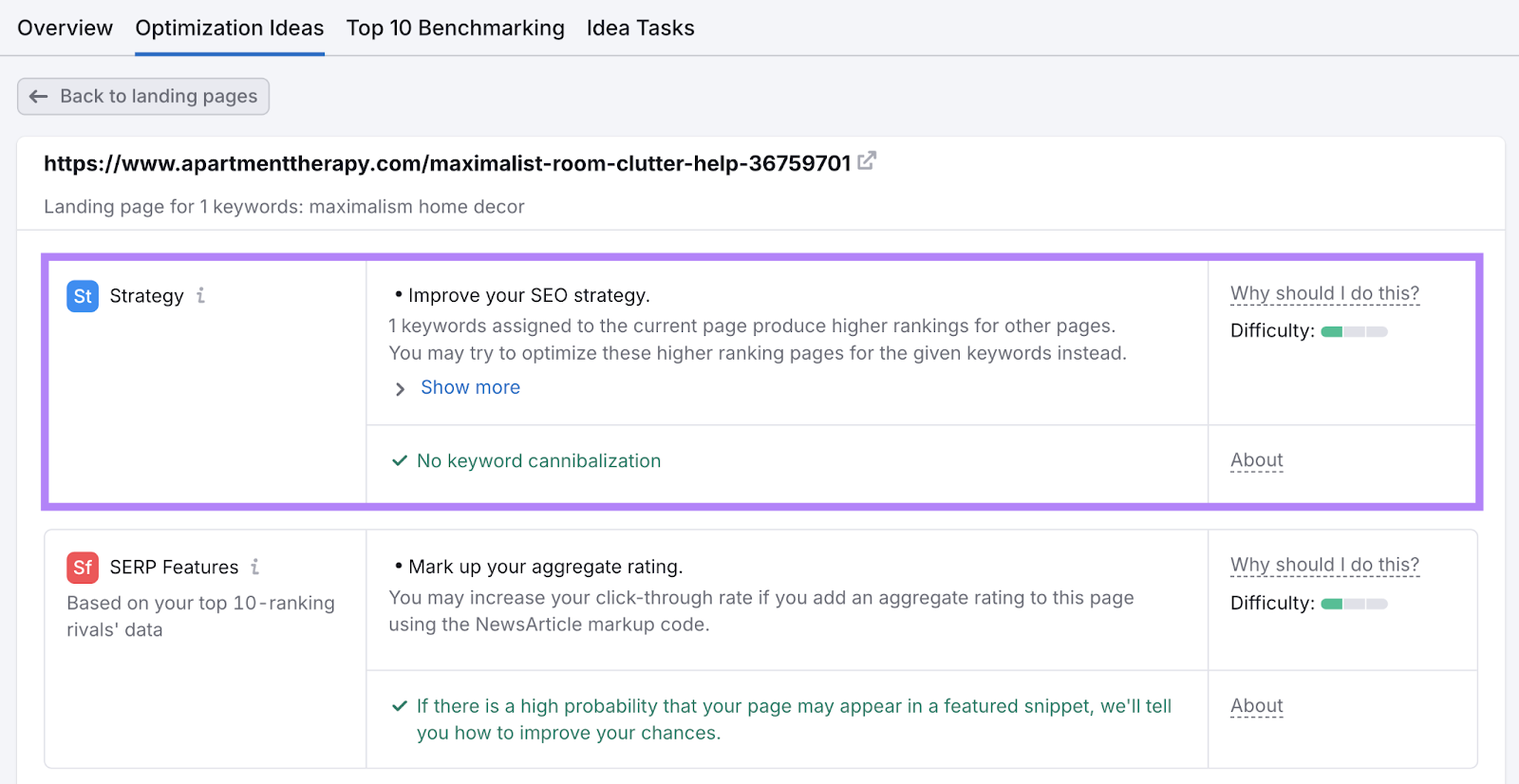
Go through and apply each suggestion for all pages listed.
9. Target All Stages of the Marketing Funnel
A marketing funnel simplifies the customer journey (the steps someone takes to turn into a loyal customer) and helps marketing teams understand the necessary content for each stage.
Content marketing funnels contain three sections: top of the funnel (ToFu), middle of the funnel (MoFu), and bottom of the funnel (BoFu).

And you should have plenty of content for each stage to ensure you’re reaching all potential customers and speaking to them where they are.
Here’s an example of what the buyer’s journey could look like for someone who wants to cover windows in their home—and some content ideas for each stage:
- ToFu: They Google “window covering ideas” to get inspiration. While searching, they come across a blog post from a company that sells peel-and-stick window privacy film.
- MoFu: They follow the company on Instagram where they see UGC showing different types of privacy films in people’s homes
- MoFu: They check out the company’s YouTube channel and come across how-to tutorials showcasing ease of use
- BoFu: They see a customer testimonial posted to Instagram and decide to buy the product
The above example is a simple buyer’s journey with different types of content for each stage.
Real-life journeys typically have many more steps. And some people might stay in certain stages longer than others or even revisit past stages.
An easy way to determine what content goes in which stage is to use the Keyword Magic Tool.
Open the tool, enter a broad keyword, and click “Search.”
Go through the keywords and pay attention to the “Intent” column.
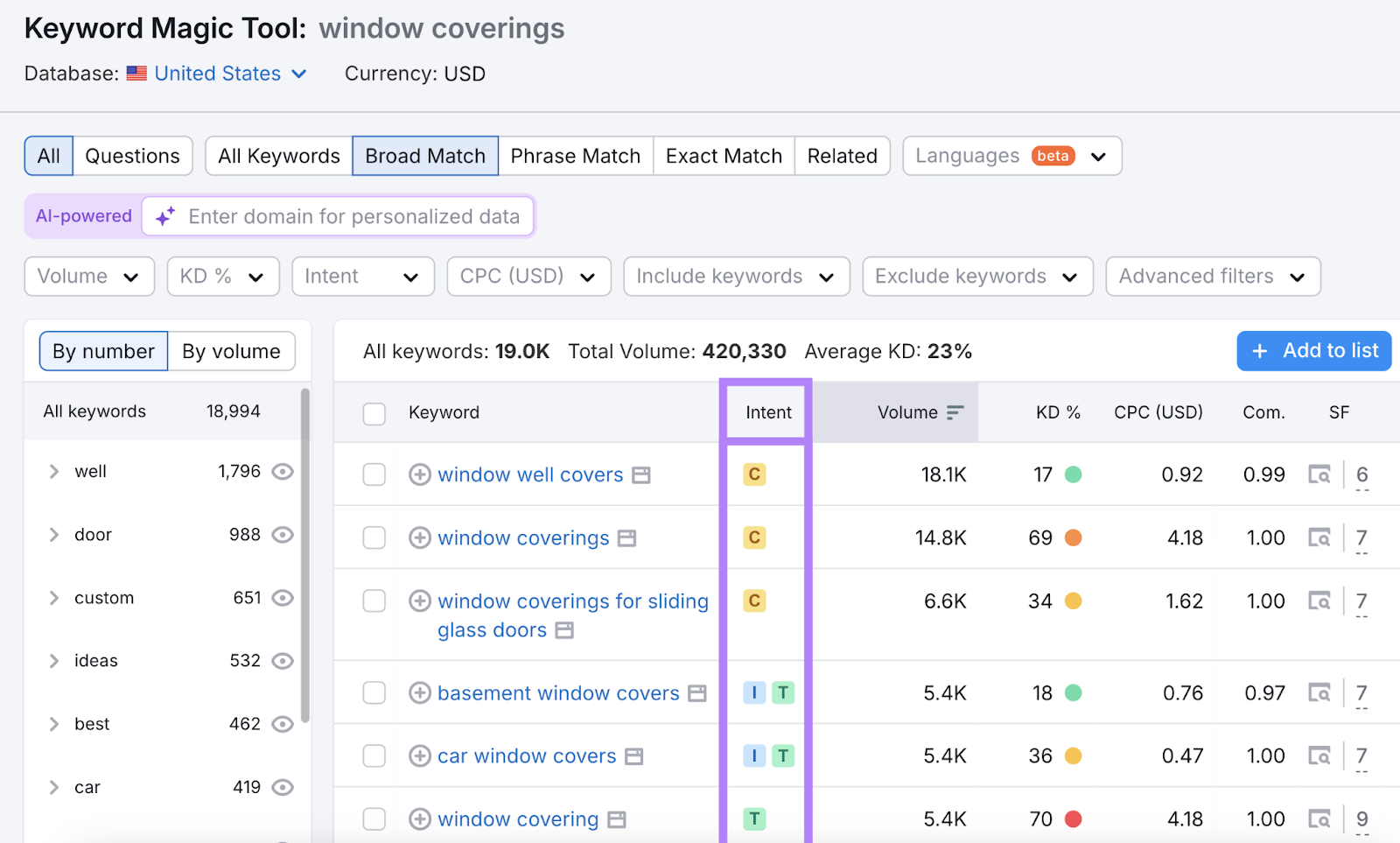
There are four keyword intent types, and they align with different stages of the funnel:
- Informational: The user wants information about a topic (e.g., “window covering ideas”). These keywords are usually ToFu.
- Commercial: The user is researching products or brands (e.g., “window privacy film vs zebra blinds”). These keywords are usually MoFu.
- Navigational: The user wants to find a specific website or page (e.g., “hunter douglas website”). These keywords are likely MoFu or BoFu.
- Transactional: The user wants to buy a certain product (e.g., “buy hunter douglas zebra blinds”). These keywords are BoFu.
Go through the keywords and make sure you select different ones to cover each stage of the funnel.
And although the Keyword Magic Tool’s data is related to search engines, you can also use it to understand your buyer's journey and come up with ideas for other types of content and platforms.
For example, the keyword “egress window covers” has commercial intent. And you may have social media followers who are near the bottom of the funnel.
So, you could create a series of Instagram posts that highlights different egress window covers through reels and static posts.
10. Create a Content Calendar
Content calendars are detailed schedules that let teams collaborate and track each piece of content and its details (e.g., status, content type, topic, its funnel stage, etc).
Here’s an example:

This birds-eye view can clue you into times when you may need to adjust your planned content.
For example, you realize blog posts have consistently outperformed videos for the past three months. But when you review your content calendar, you see that your team is planning to mainly produce videos.
Knowing this, you can adjust your plans to focus on more blog content.
Spreadsheets often make suitable (and budget-friendly) options for creating content calendars. Or, you can use a project management tool like Monday or Asana.
11. Repurpose Content for Different Channels
Content repurposing is when you reuse—and tweak—content for different channels, which can save you time and money.
For example, here’s a section from one of our blog posts:
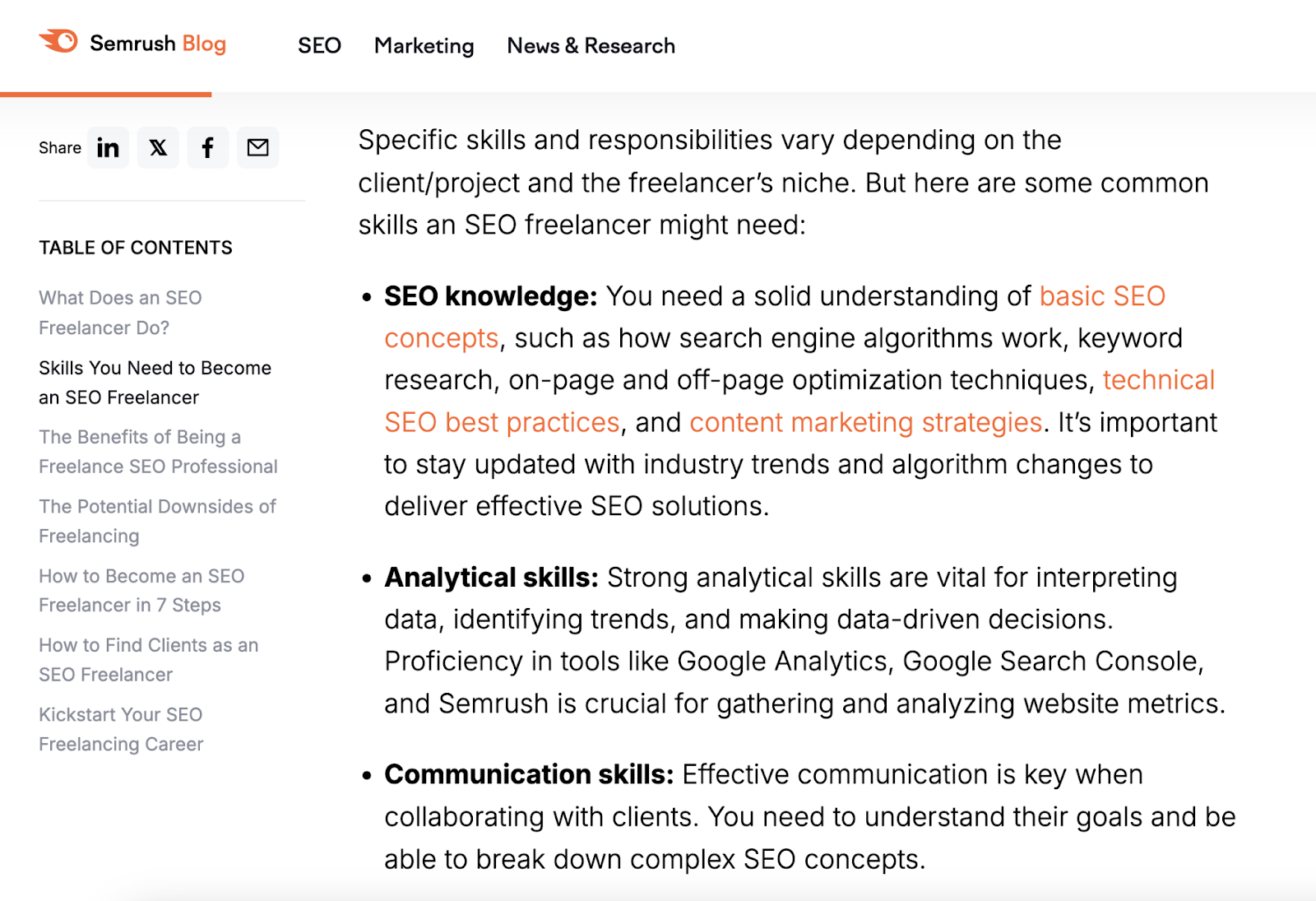
We took the bulleted text and turned it into a graphic for Facebook:

Here are some ideas for repurposing your content:
- Extract quotes from written content and turn them into social media graphics (like we did in the example above)
- Take podcast show notes and reformat them into blog posts (or do the opposite and turn blog posts into podcast episodes)
- Take long-form videos (like YouTube content) and divide them into smaller videos for Instagram Reels, YouTube Shorts, and TikTok videos
- Create summaries of blog posts and send those summaries to your email list
- Convert webinars into lead magnets (assets people receive in exchange for their email address)
- Turn blog posts into videos
If you’re looking to turn blog content into videos, try the AI Video Marketing Automator app.
Click “Get for Free,” head into the app, and select “URL to Video.”
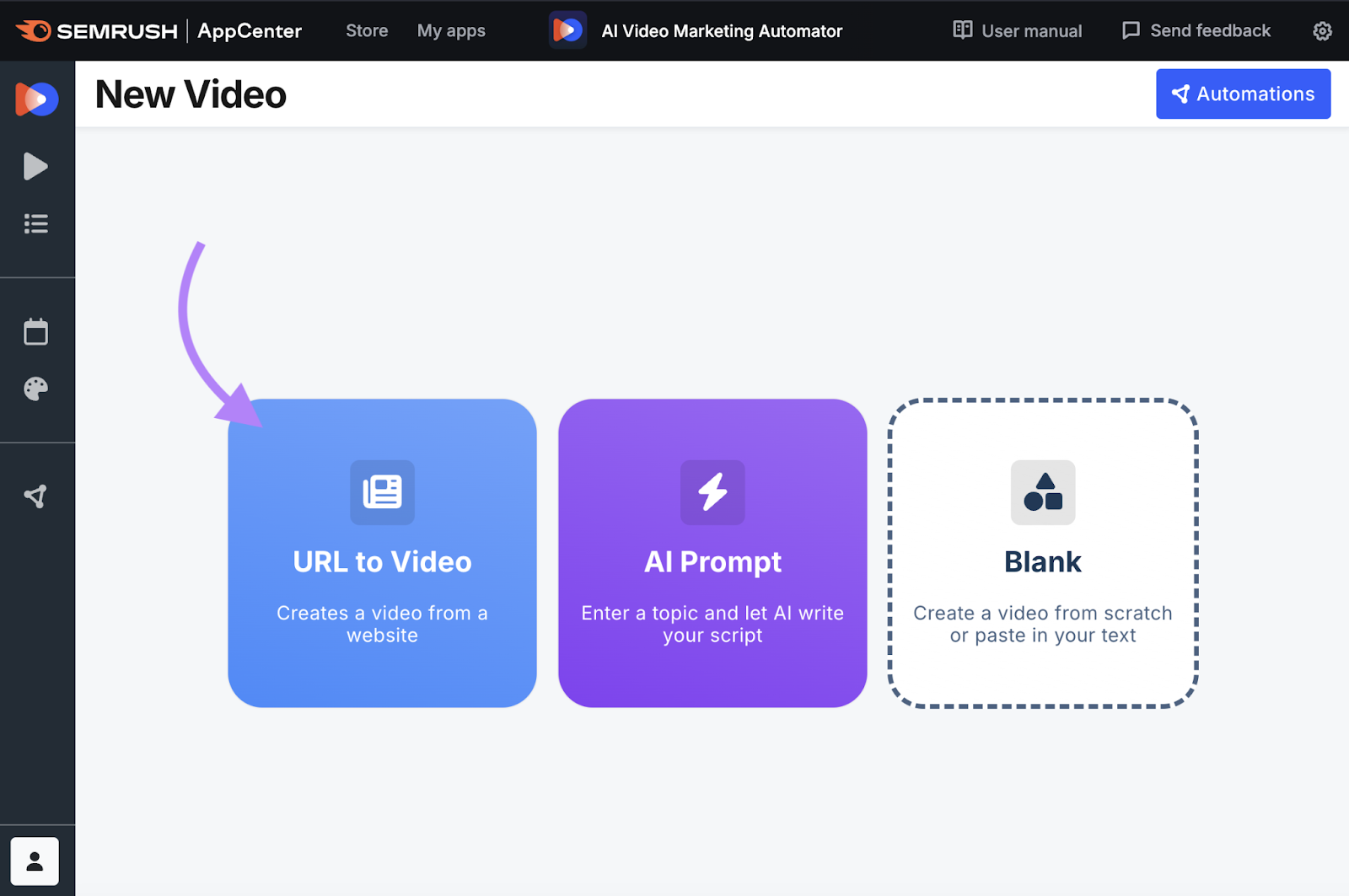
Fill out the pop-up window and click “Create Video.”
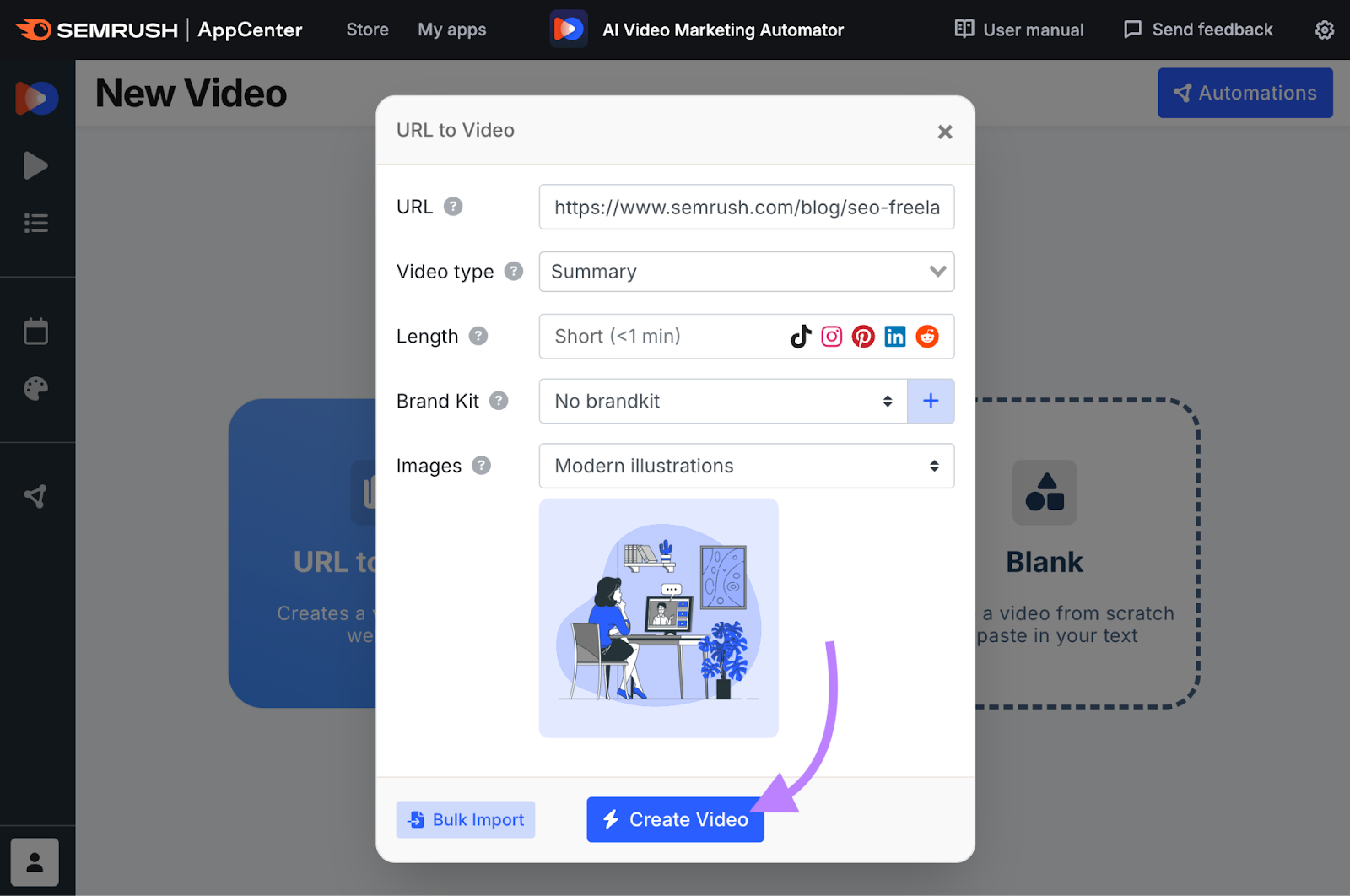
The tool will spend a few minutes creating your video.
Once it’s finished, you can adjust things like the voice, style, music, the content, and more.
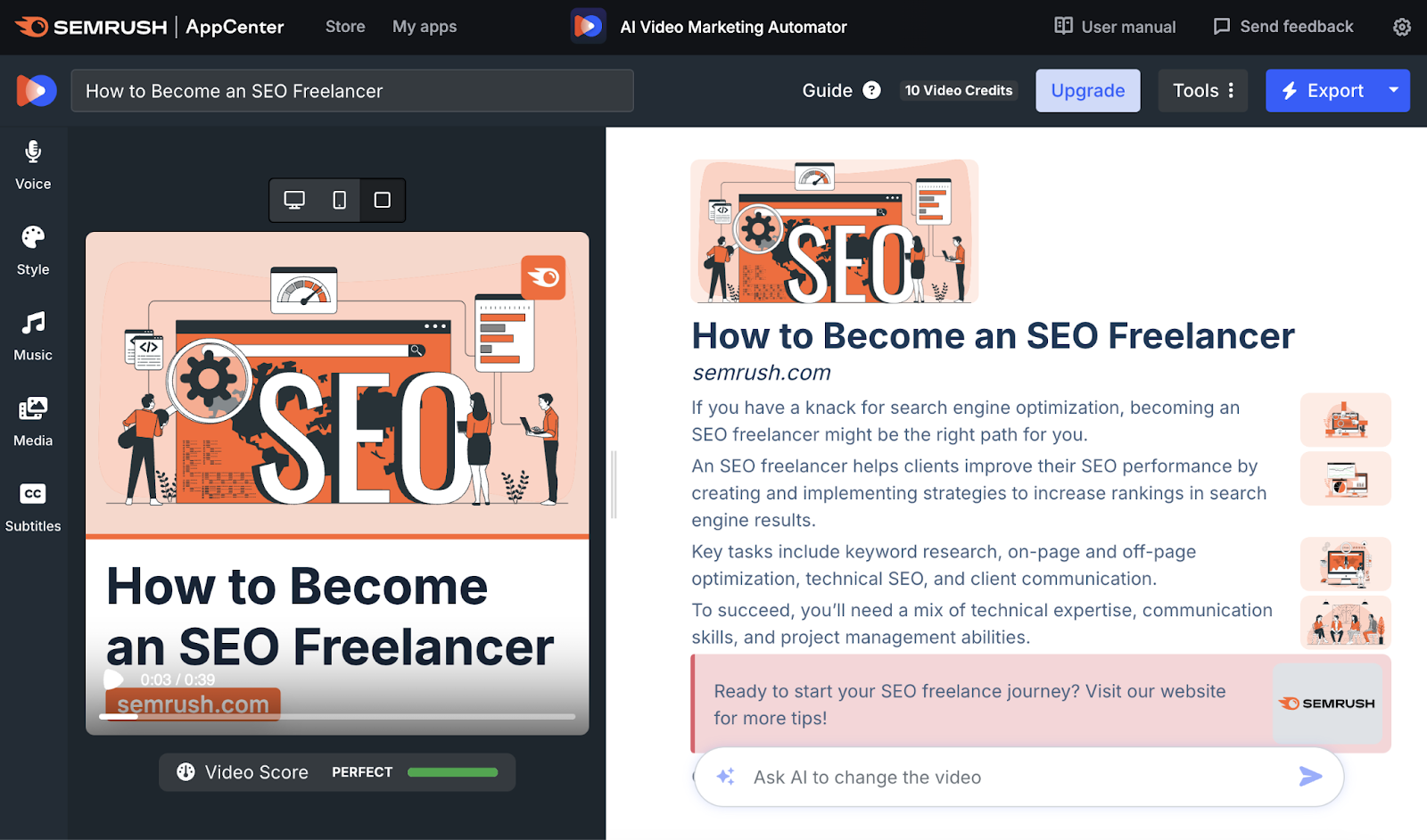
12. Use Subject Matter Experts’ Insights
Subject matter experts (SMEs) are people with a high level of knowledge in a particular area that you can include in your content to build thought leadership—when you share influential and highly educational content that positions your brand as an expert in your niche.
SMEs can be internal (people who work for your company) or external (other experts in your niche).
Here’s how Hotjar uses internal SMEs to weave expertise into blog posts:

You can find potential SMEs to partner with by:
- Reaching out to in-house experts
- Checking contributors in industry publications
- Networking at events
- Engaging with authors of relevant studies
Then, come up with a plan for how you’d like to partner with each SME.
For example, you might want an in-house expert to write a blog post. Or, you could interview an industry expert on your podcast.
13. Create a Mix of Evergreen, Seasonal, and Trending Content
Publishing a mix of evergreen, seasonal, and trending content helps you maximize engagement and reach.
There are three main types of content based on lifespan:
- Evergreen content remains relevant over a long period of time—sometimes even years. And you don’t need to make major updates frequently. Like a blog post with tips for painting interior walls.
- Seasonal content is tied to specific events, holidays, and seasons. It doesn’t hold relevance over an entire year but may be relevant at the same point in time for several years to come. Such as a blog post with Halloween recipes.
- Trending content is content that’s highly relevant for a short period of time and can give you a quick burst of interaction as people look up the trend. Like our Instagram post that references the “demure” trend of August 2024:
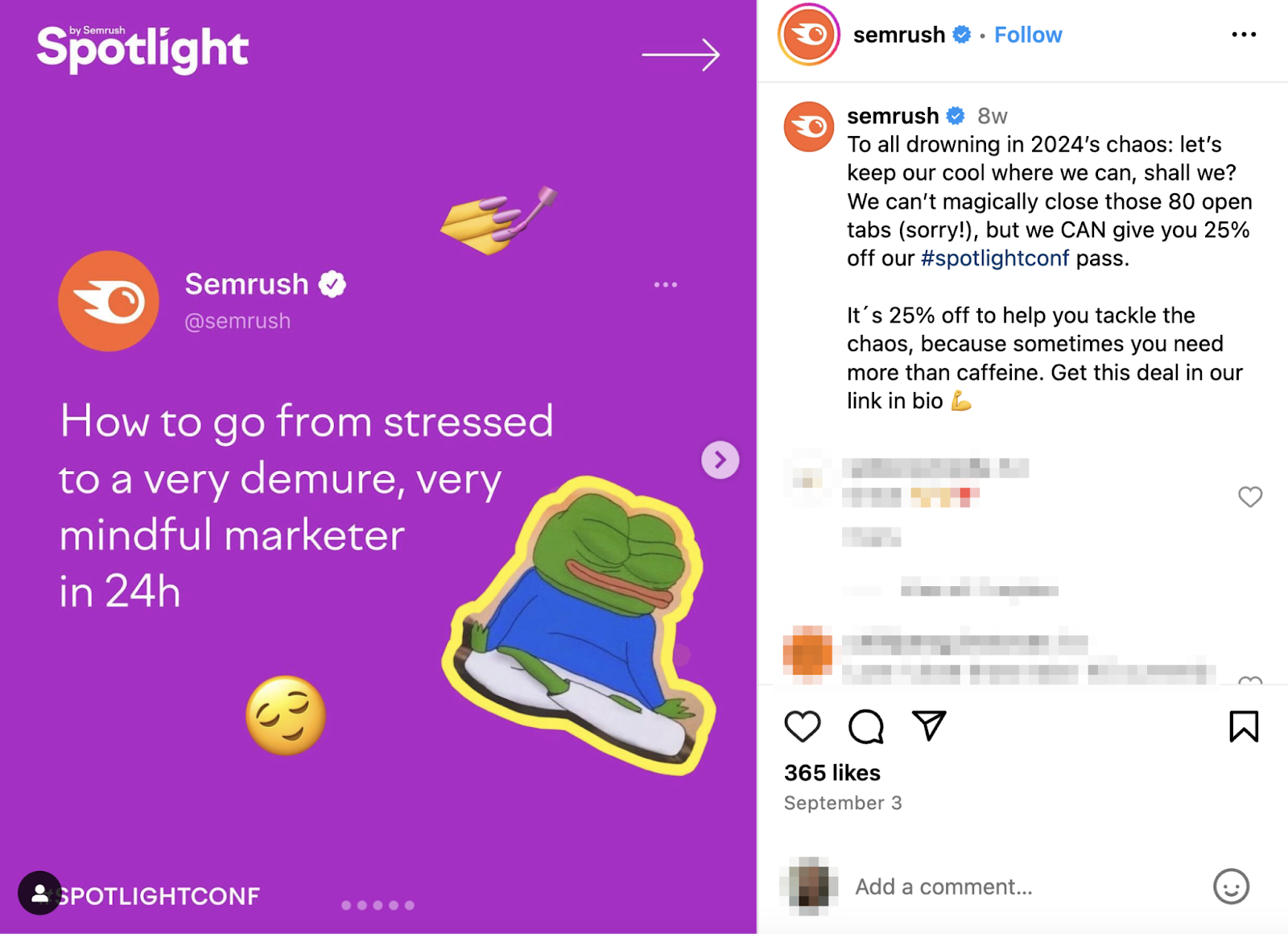
Figuring out how much evergreen content to make versus seasonal and trending content requires experimentation.
We recommend tracking your content’s results to see which type of content performs best and which type yields the highest return. You can adjust from there.
14. Use AI When Appropriate
Using AI in content marketing can speed up your processes and help you come up with more ideas. But you shouldn't rely on AI to create polished, ready-to-publish content for you.
Why?
Because there’s risk of bias, hallucinations, and even plagiarism.
But by knowing those risks you can build checks and balances into your content creation process to avoid them.
For example, instead of writing an entire blog post with generative AI, you can use it to review human-written blog posts and give you tips for things like SEO and readability.
Semrush’s SEO Writing Assistant is an AI-powered tool that’s useful for optimizing content.
Just enter your blog post’s keywords into the “Keywords” area, adjust the target audience, and click “Get recommendations.”
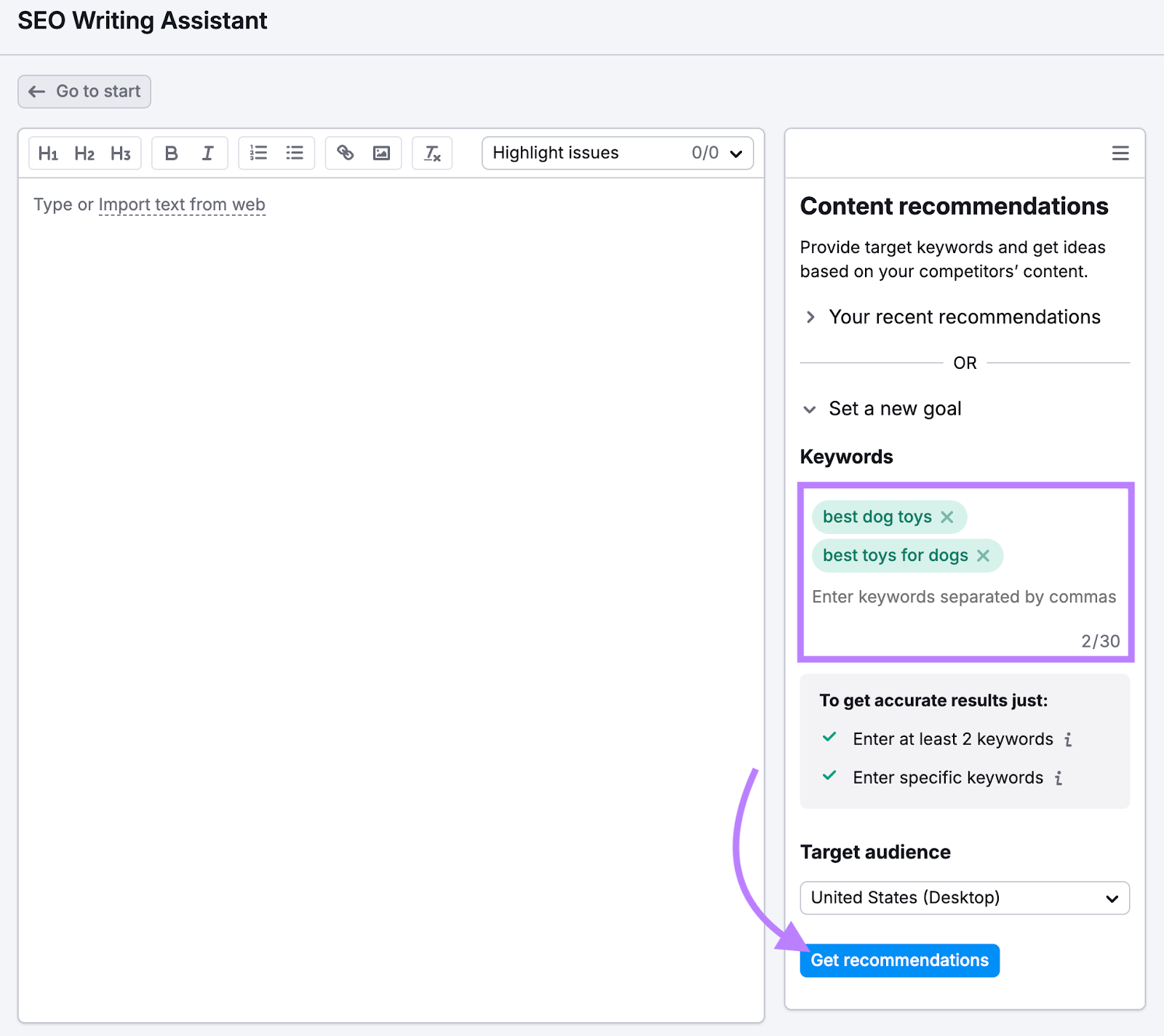
Then write your blog post directly in the editor or copy and paste from elsewhere.
The tool reviews what’s already ranking in the search results to give you recommendations on how to improve your own content. And provides recommendations for readability, SEO, originality, and tone of voice.
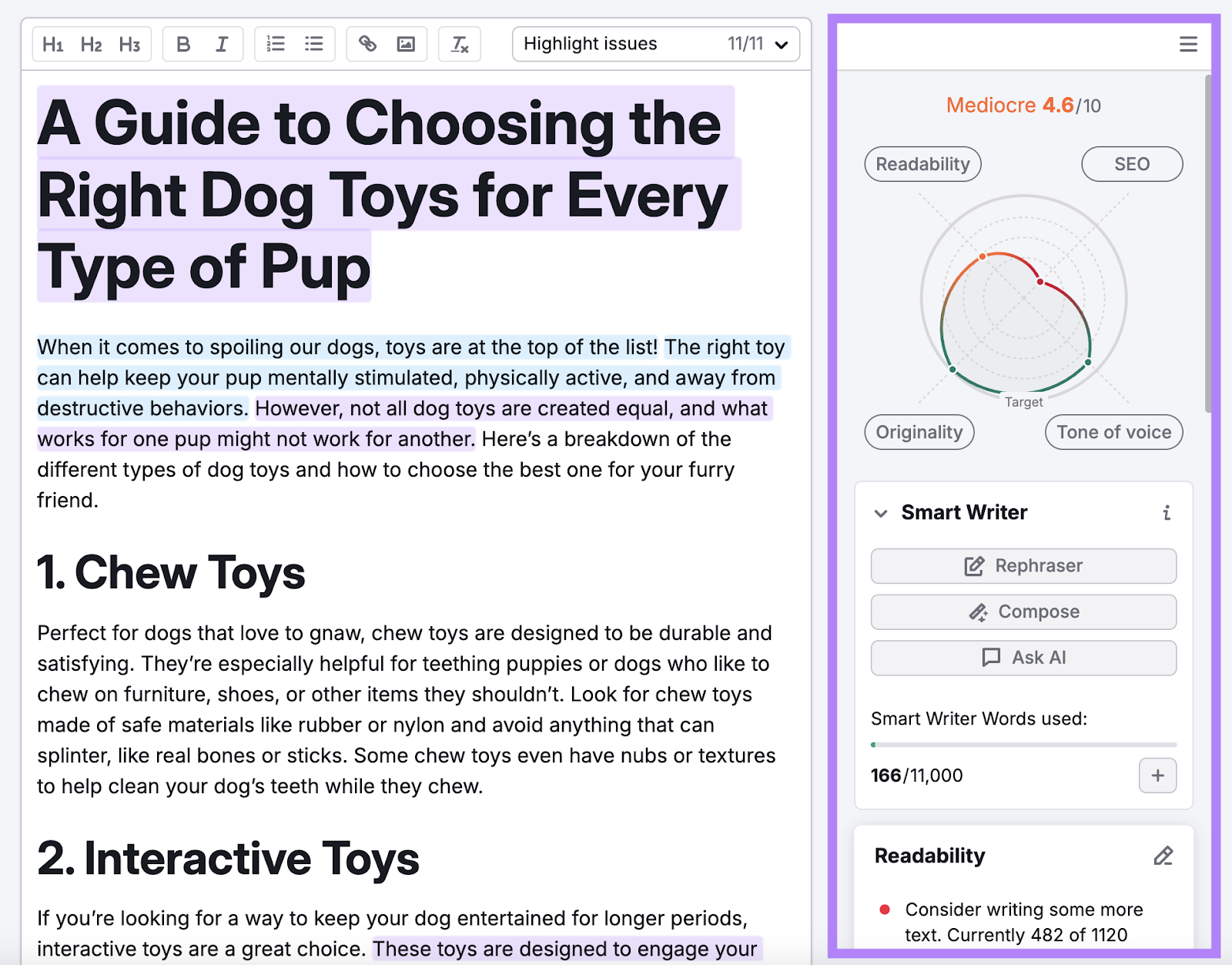
If you get stuck, you can use the Smart Writer features to compose AI-generated text or rewrite existing text.
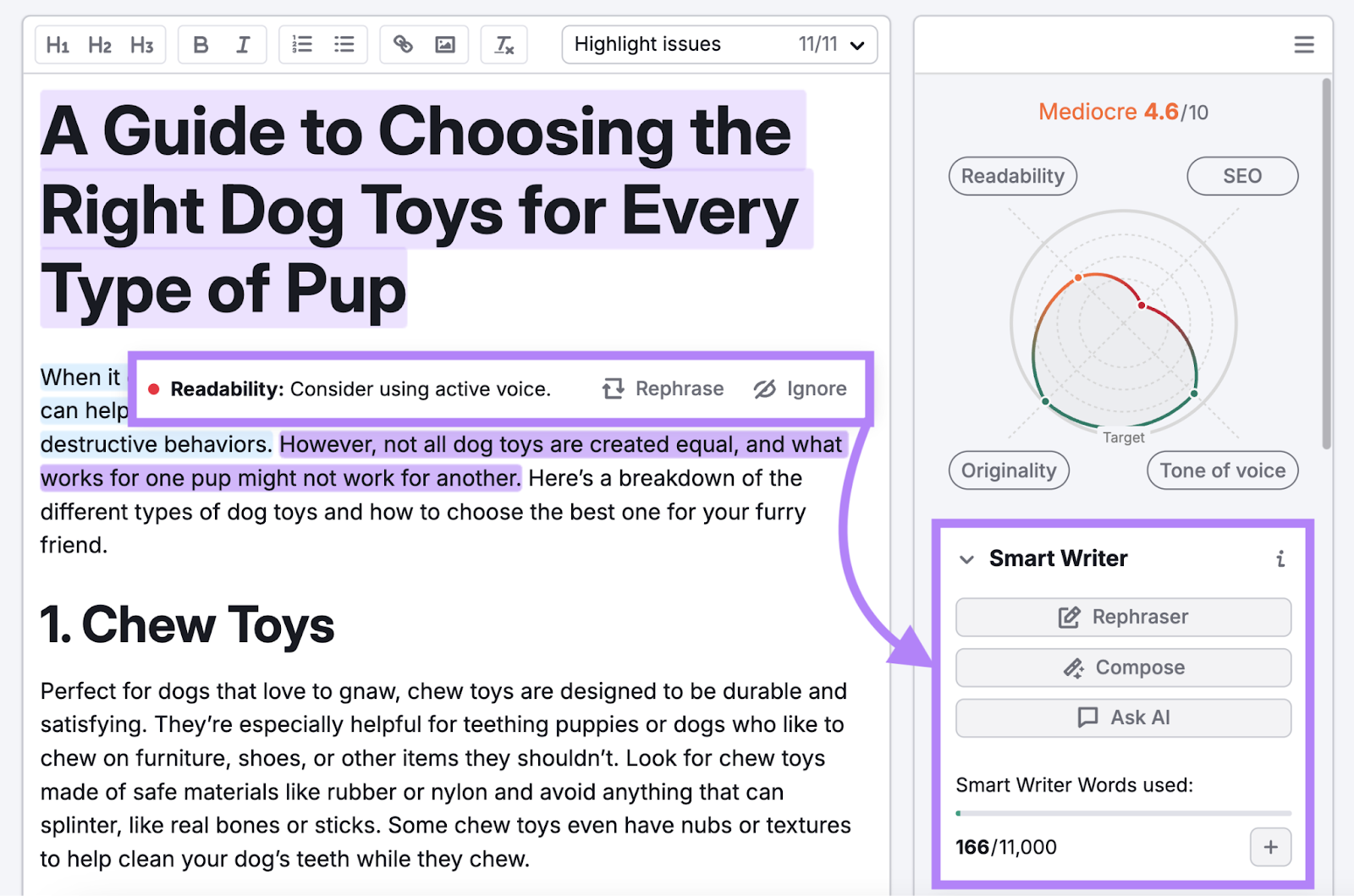
15. Measure Results
Measuring your content’s results lets you see what needs improvement and whether you need to adjust your strategy.
Review the KPIs that align with your goals because those are the metrics you should track.
For example, let’s say you’re aiming to grow brand awareness by increasing your number of new followers across social media. Semrush’s Social Analytics tool tracks this for Facebook, LinkedIn, TikTok, and Instagram.
But it also lets you review a host of other metrics to provide even more insight into your performance and what you might need to do to improve.
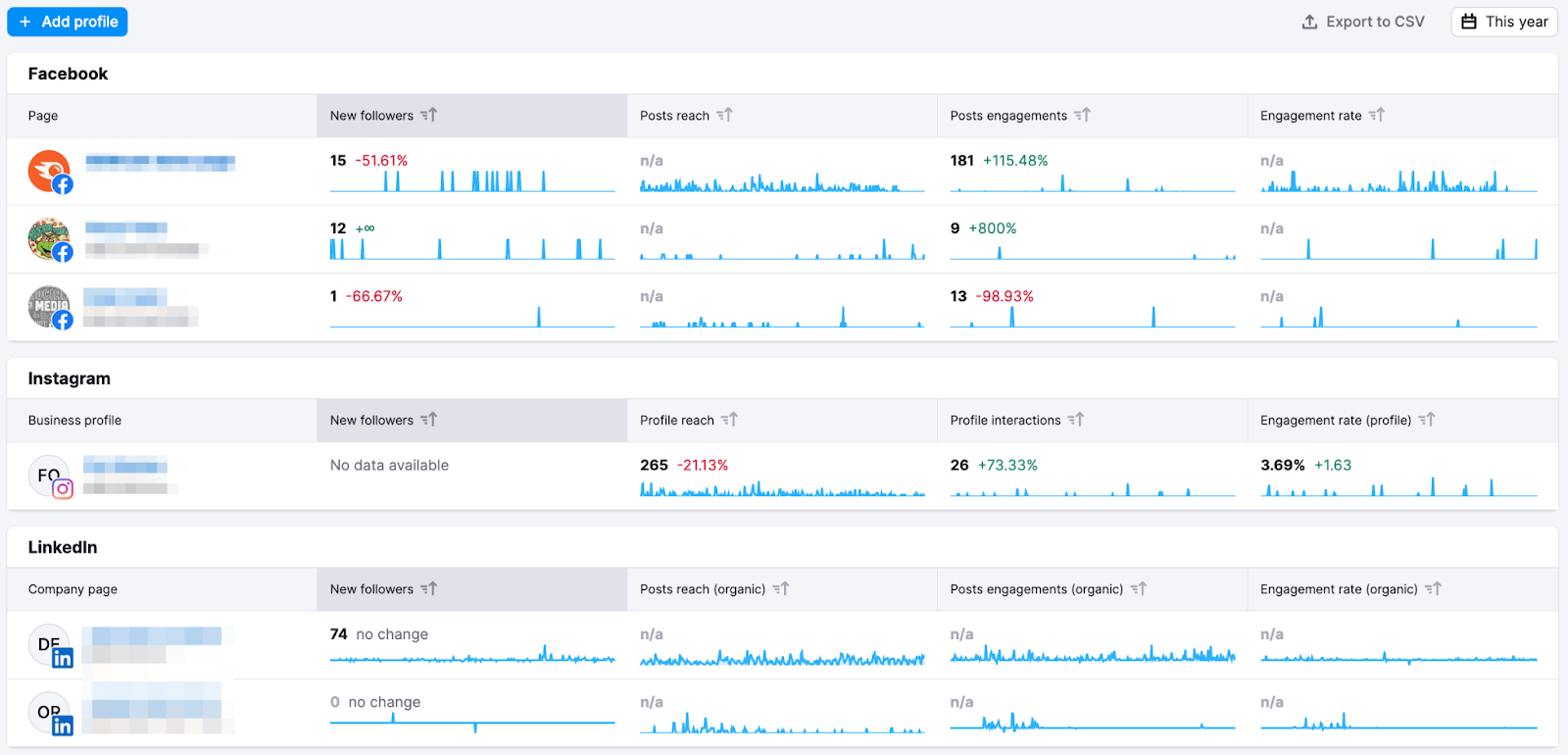
And Organic Traffic Insights combines data from Google Analytics, Google Search Console, and Semrush into one dashboard. So you can easily monitor website-related KPIs like click-through rates, sessions, and keyword rankings.
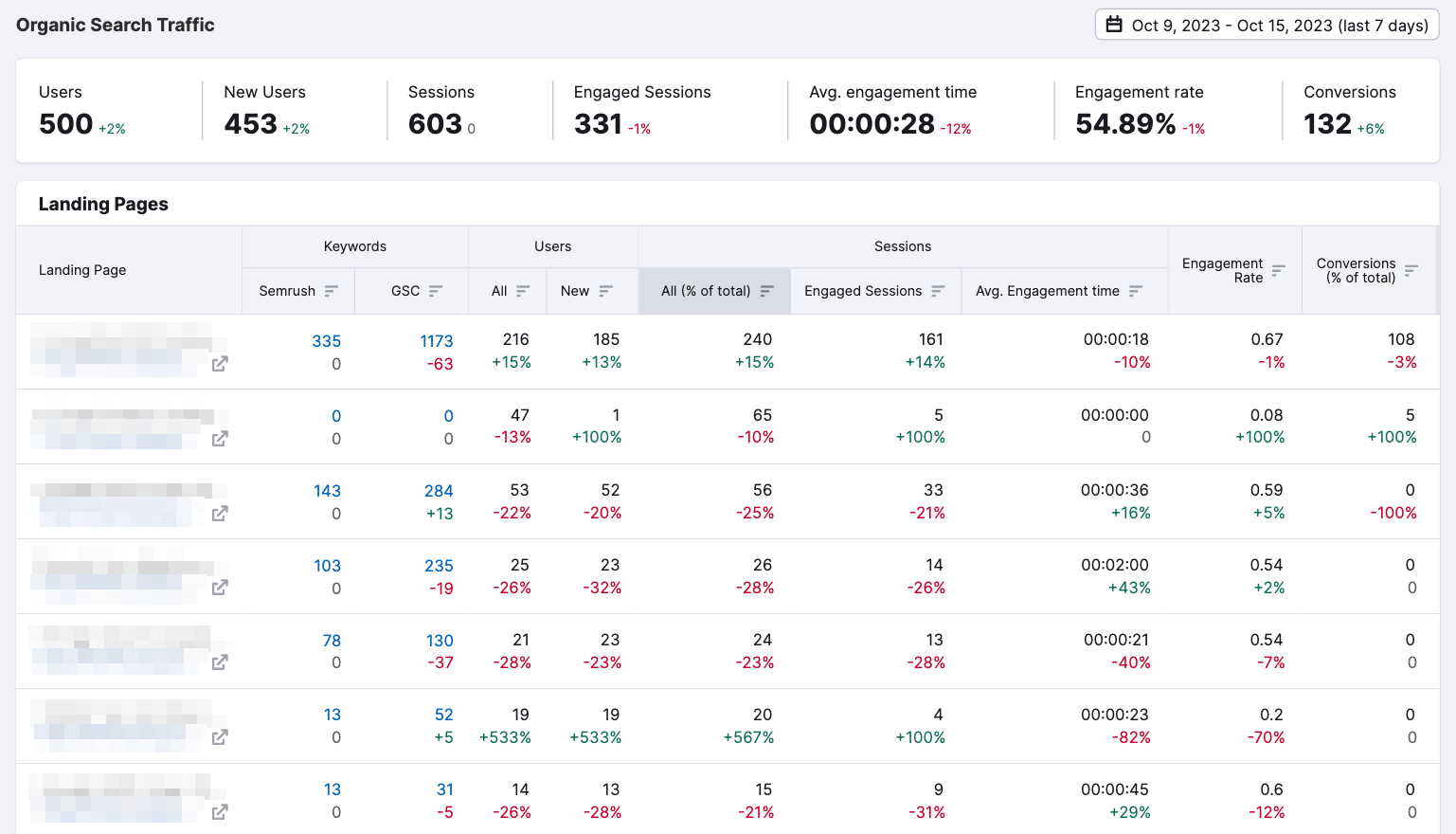
Elevate Your Content Marketing Endeavors
Content marketing has many moving parts that follow the buyer’s journey across social media, webpages, email, and more.
Semrush has a variety of tools that can help you follow these best practices across your content efforts.
Ready to try them?
Get your free trial today.
